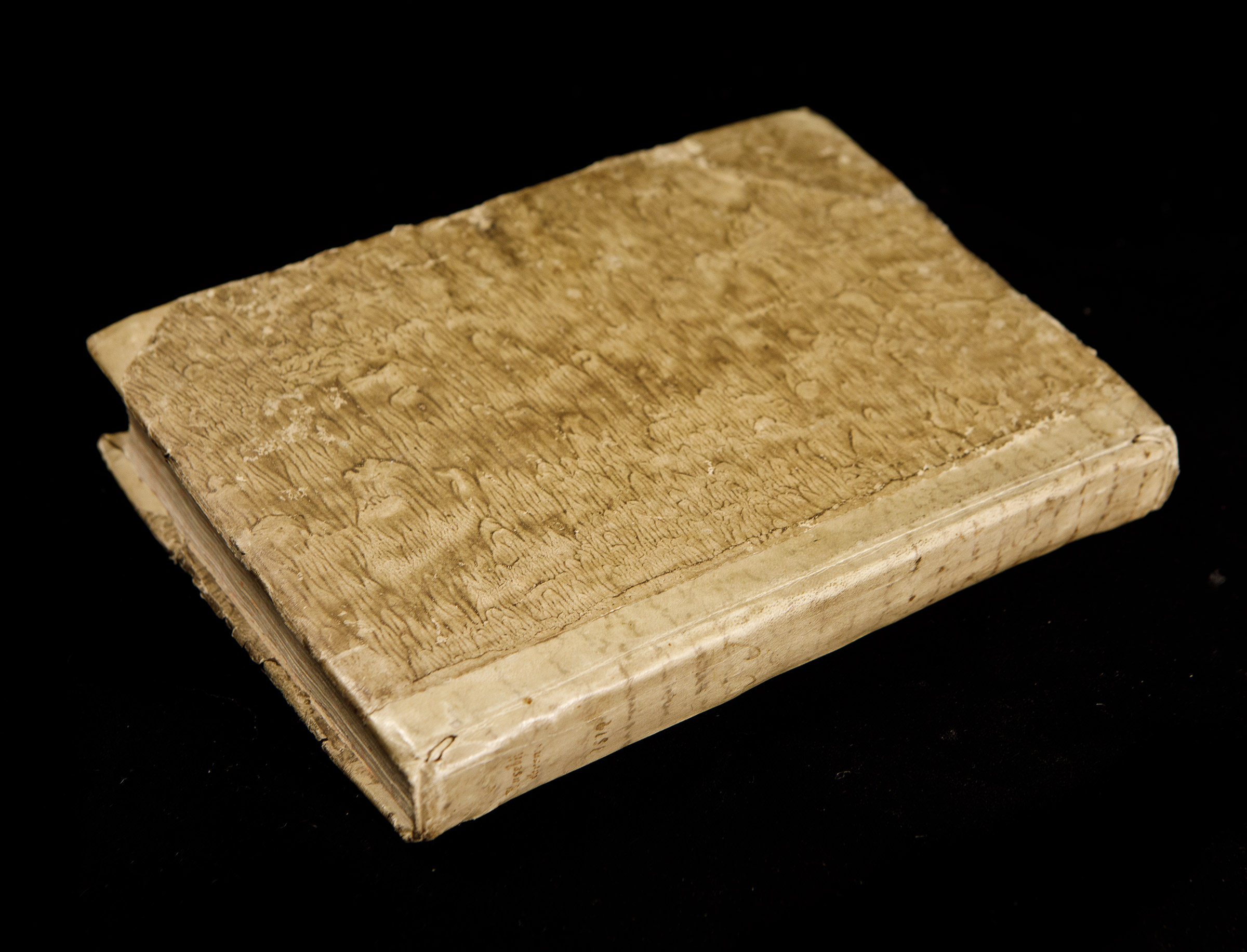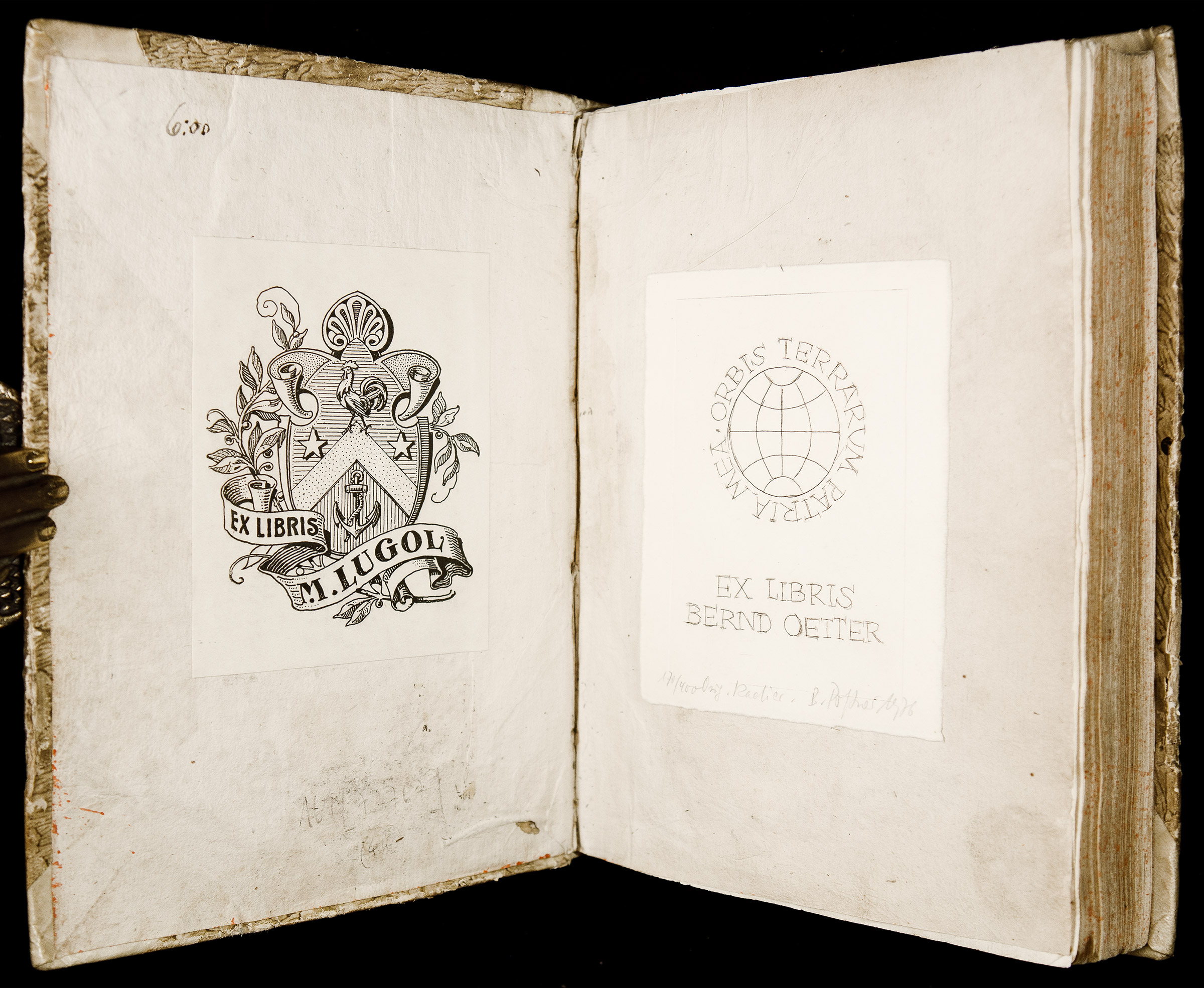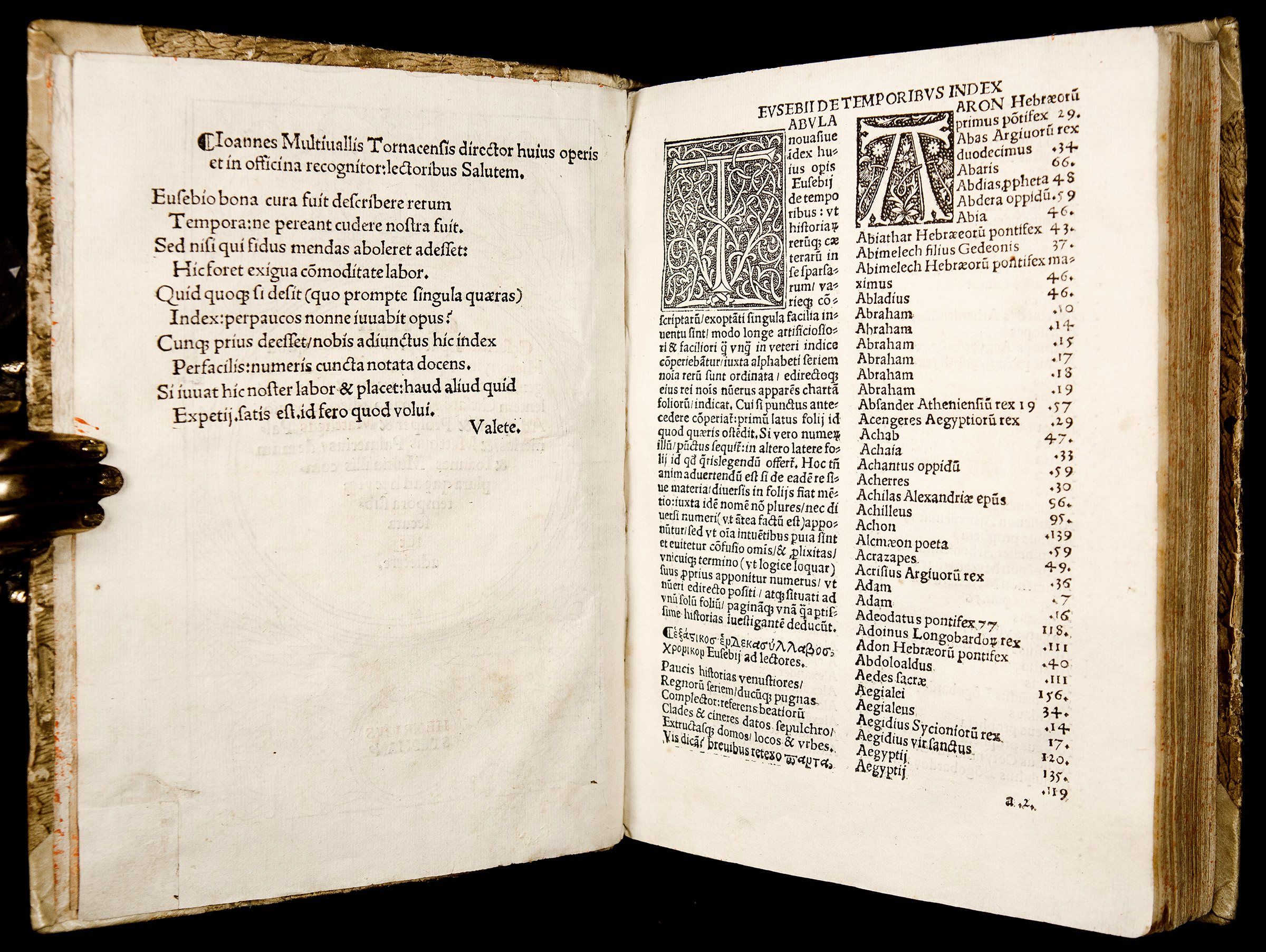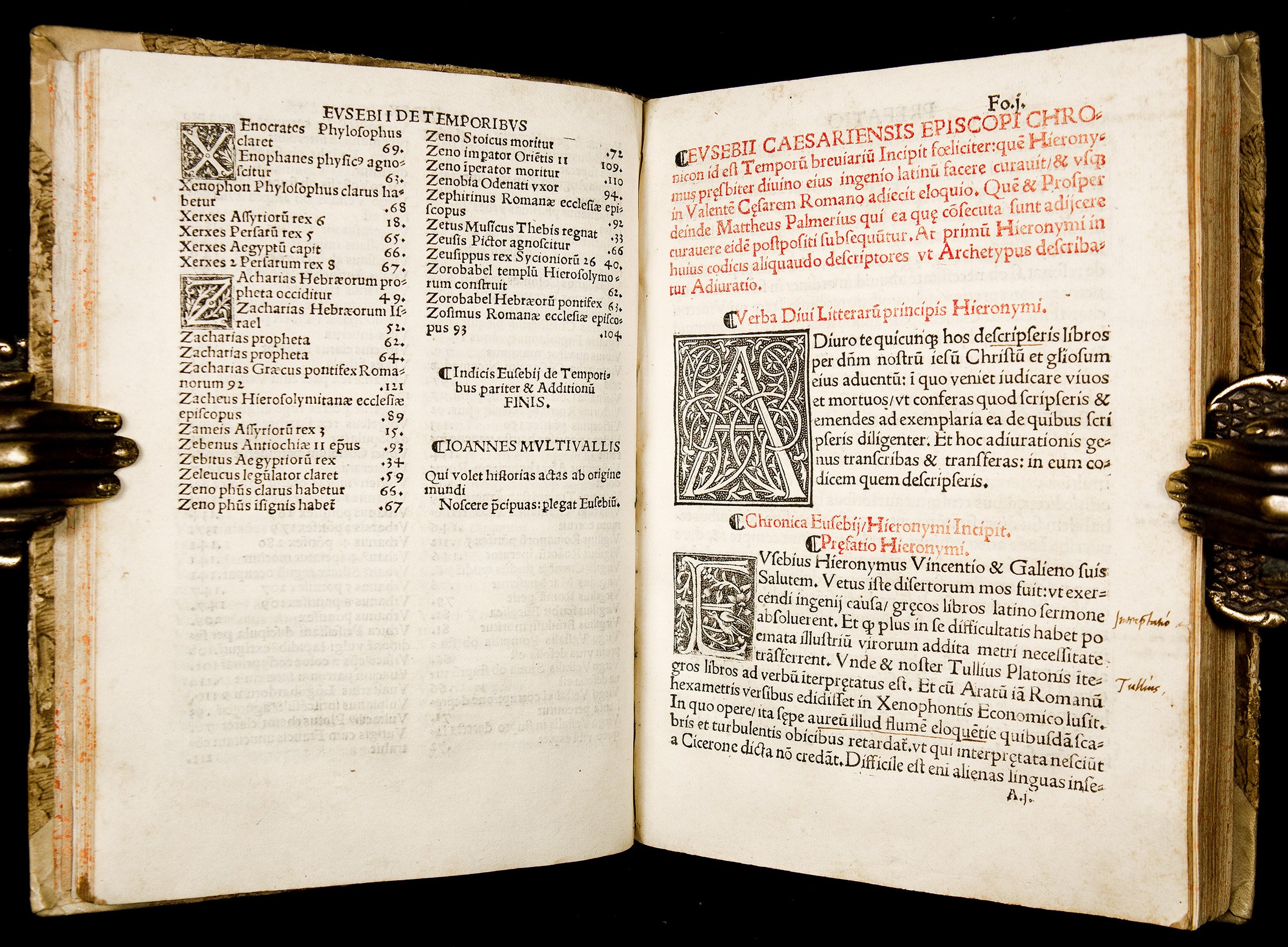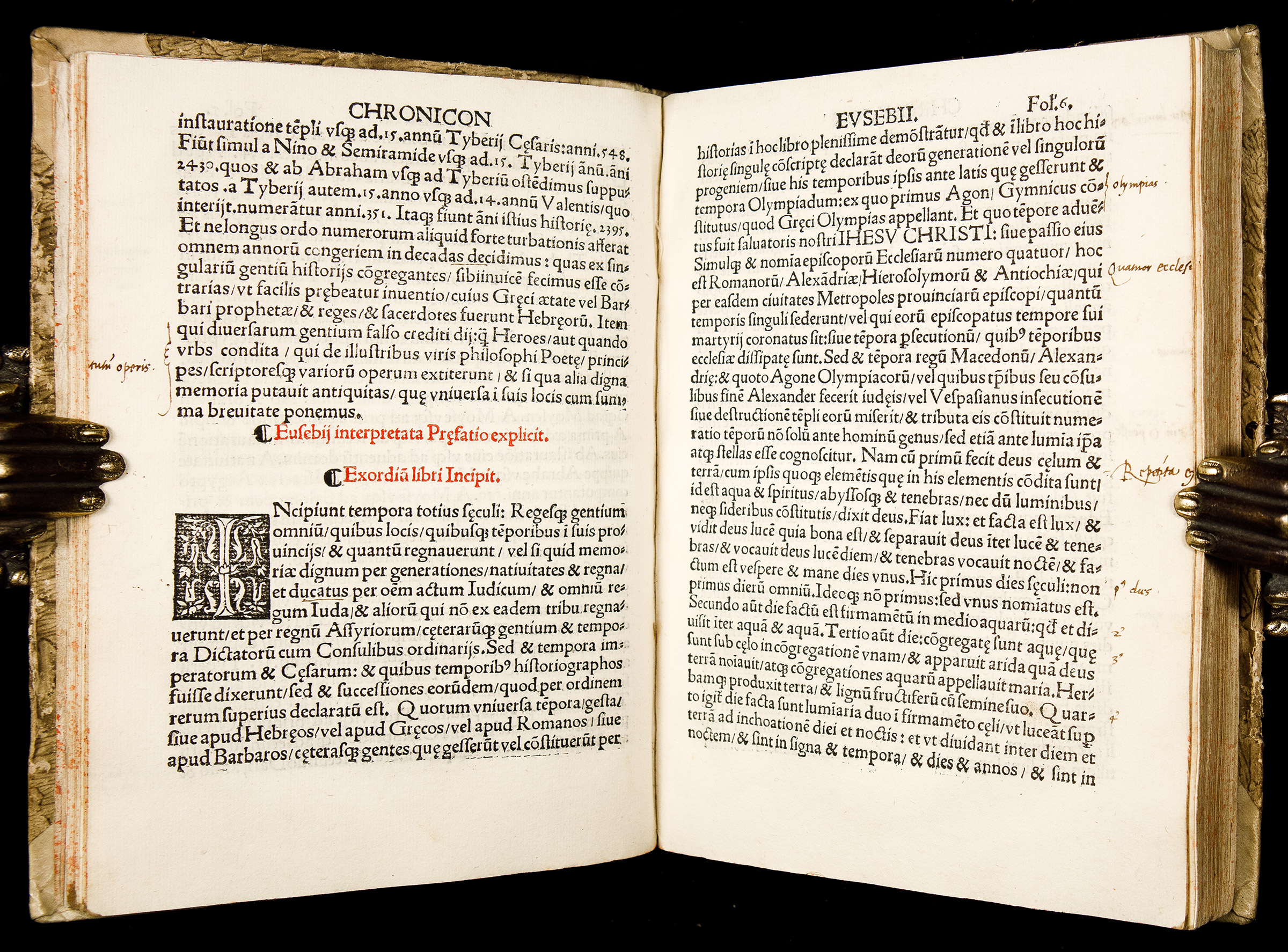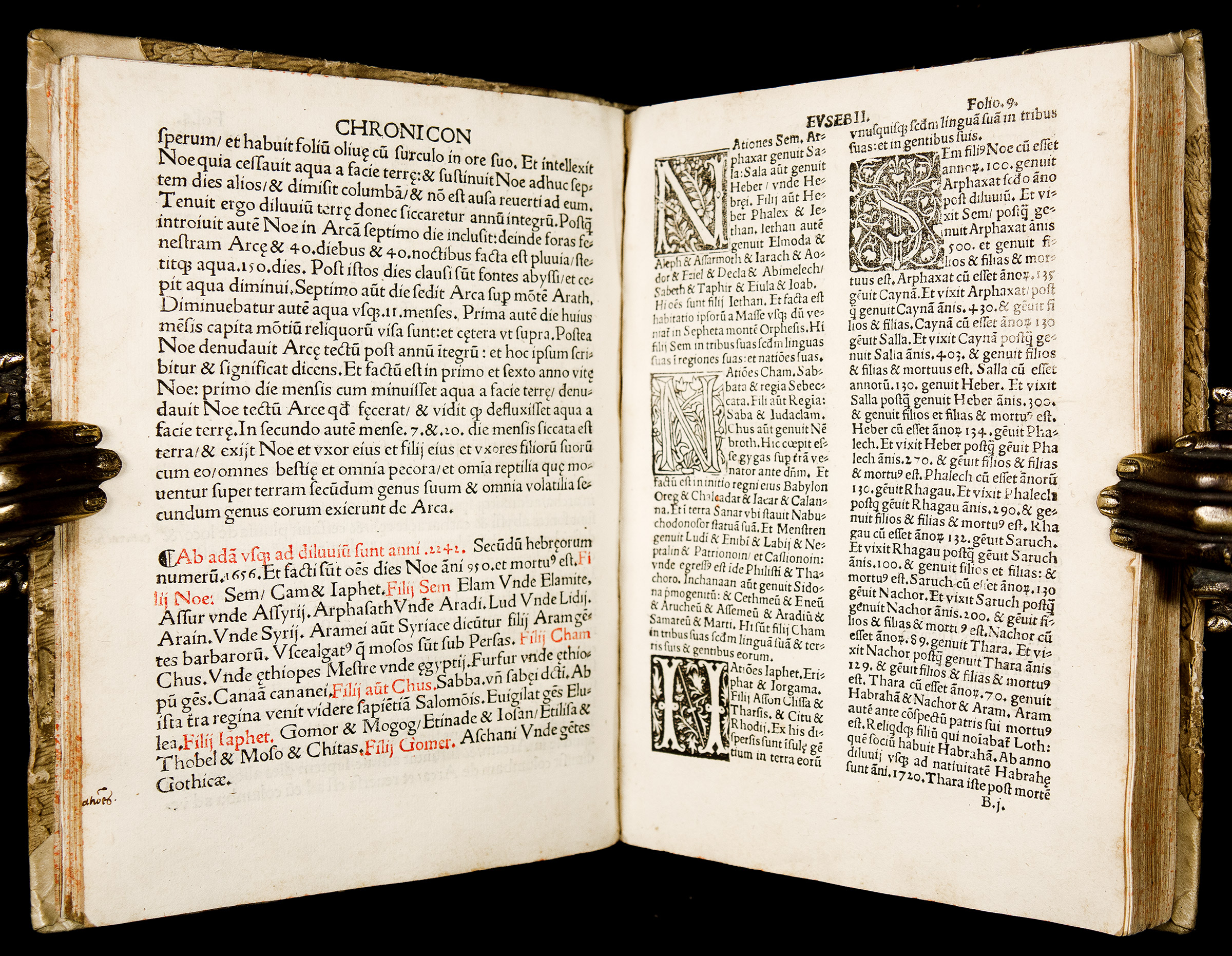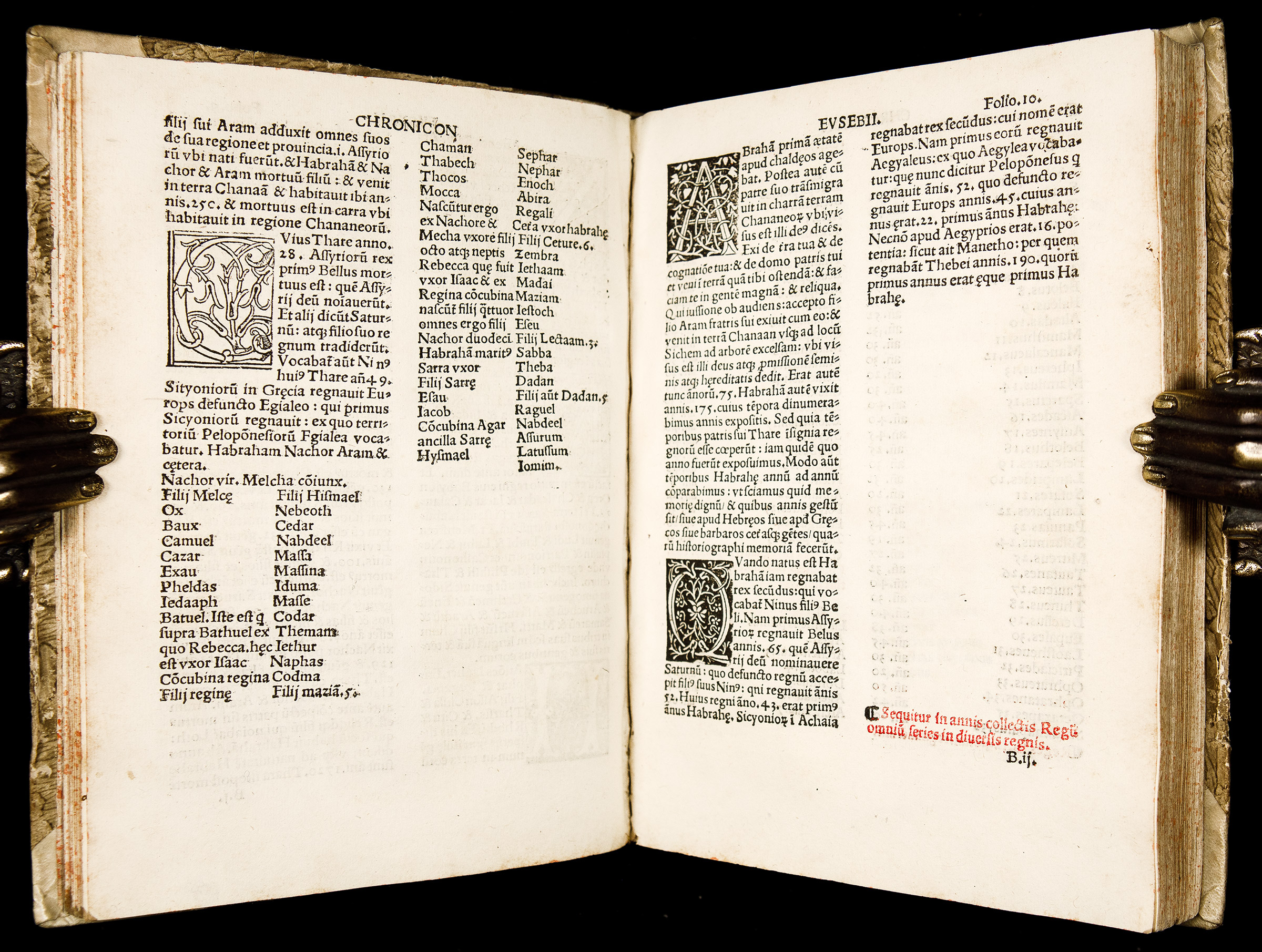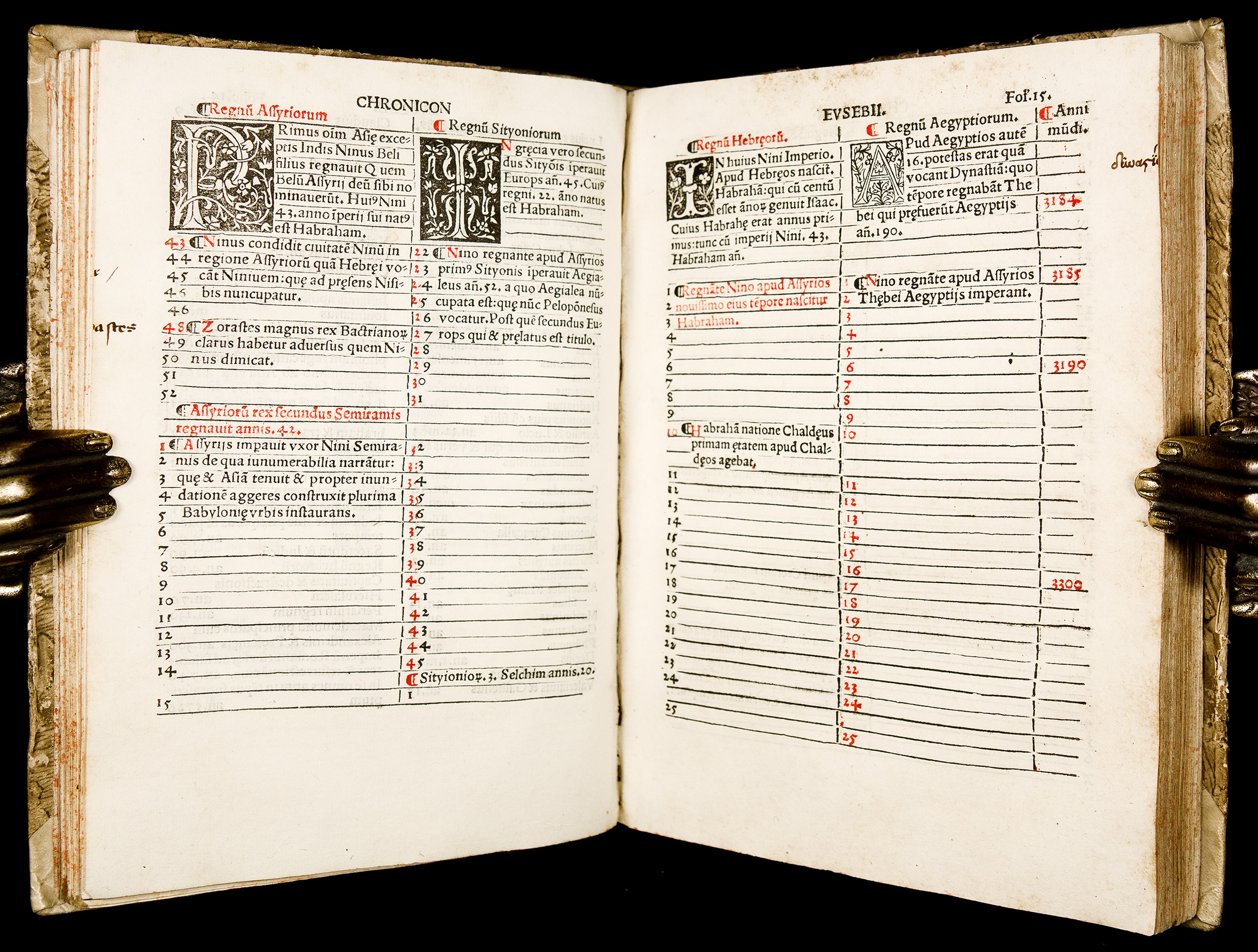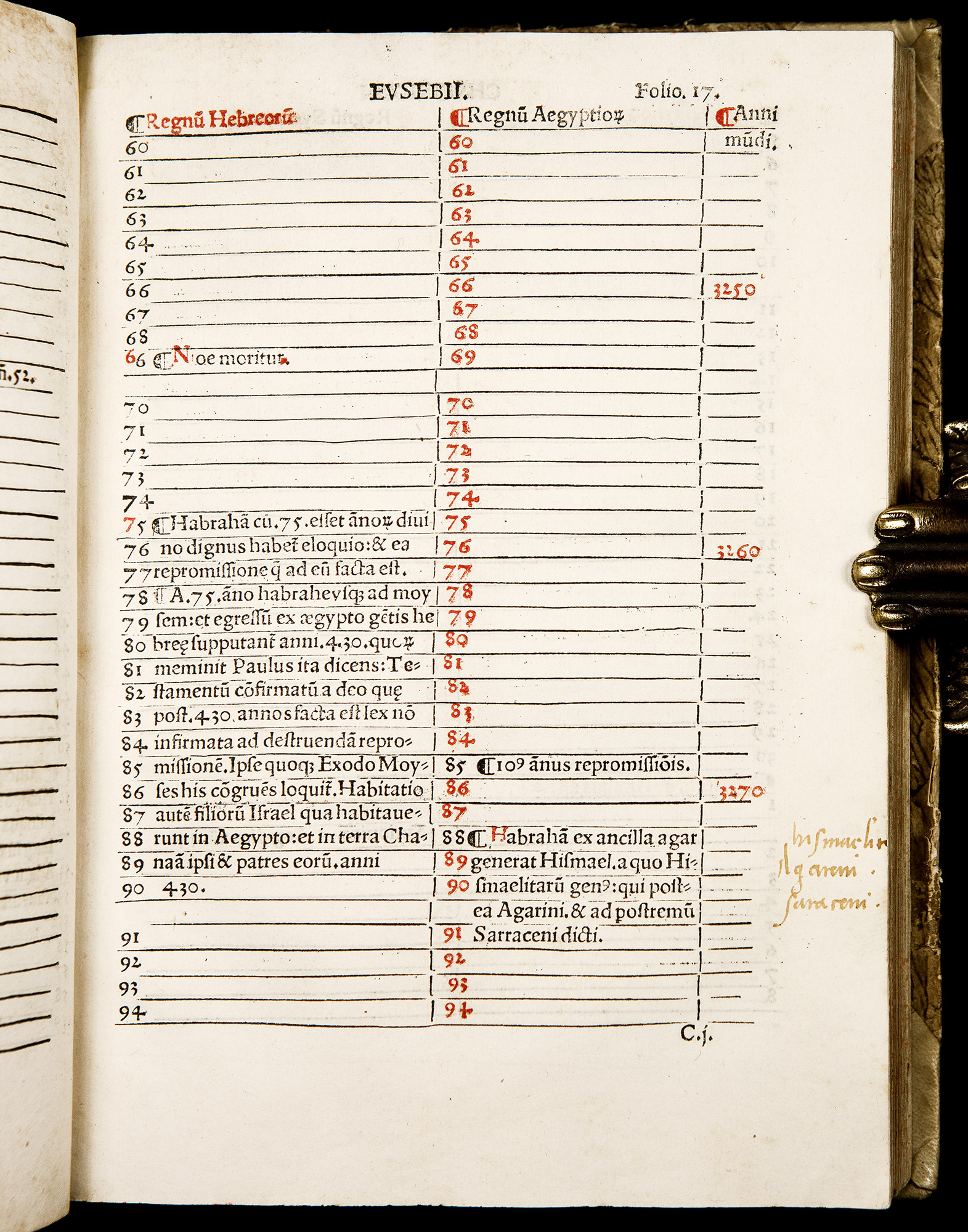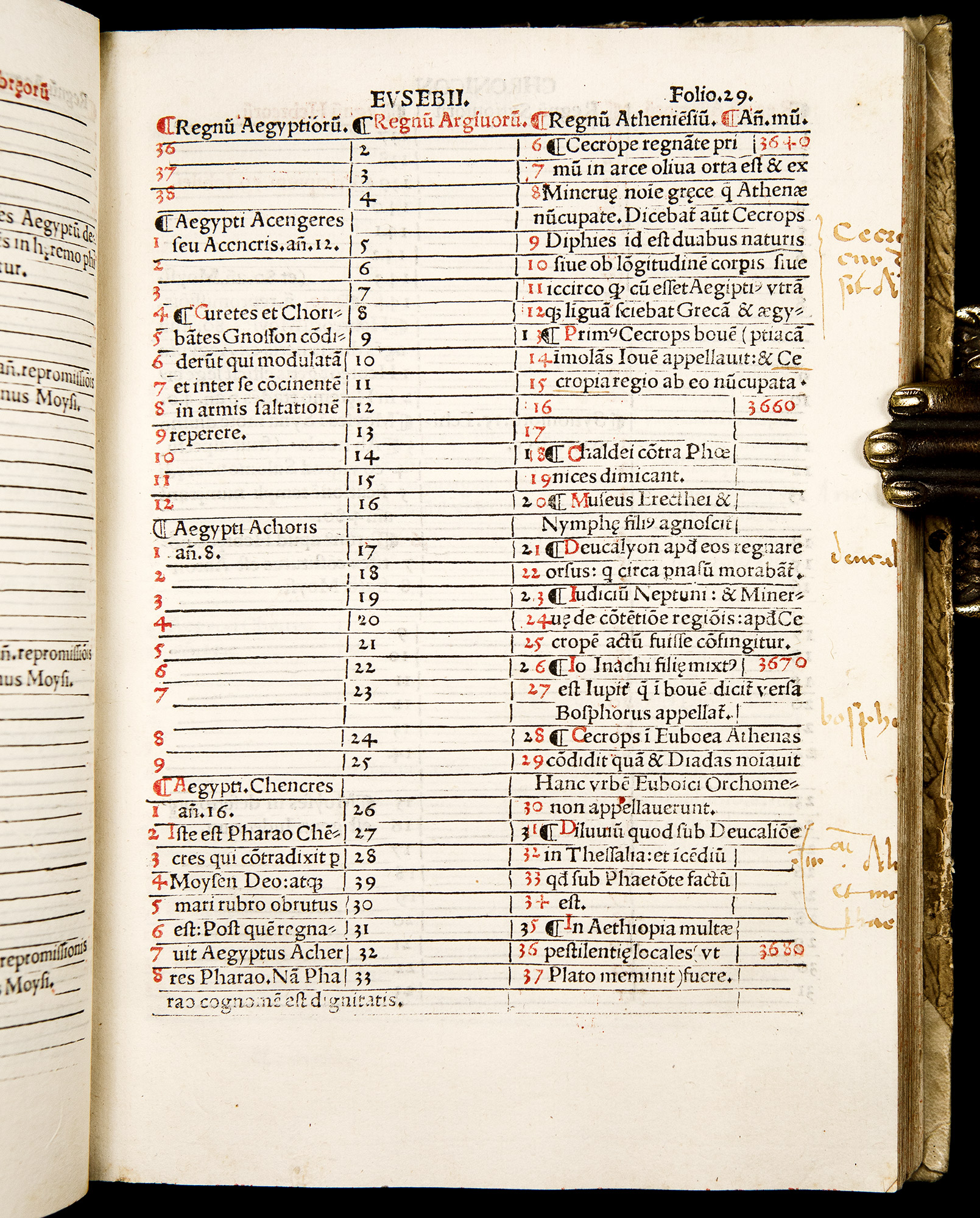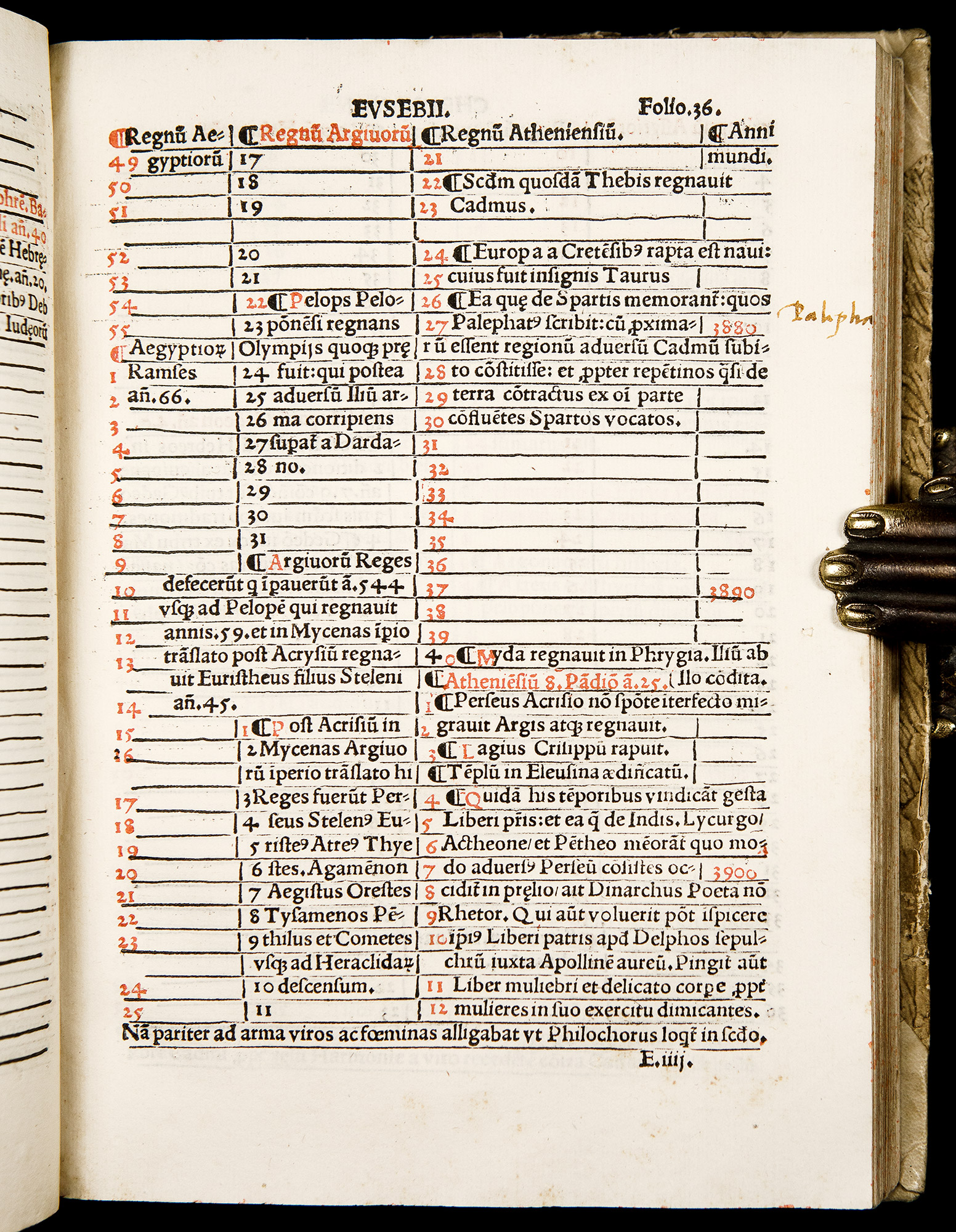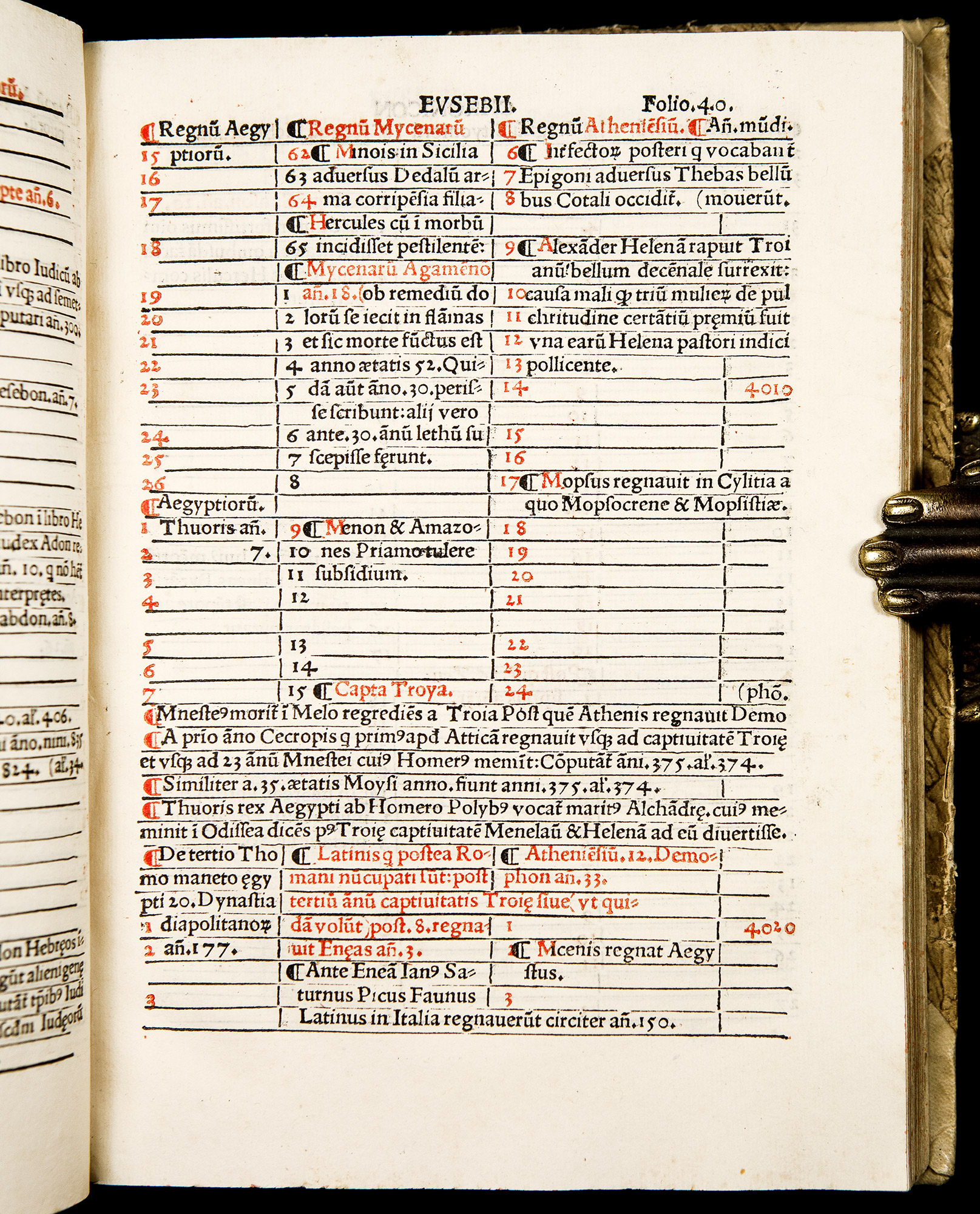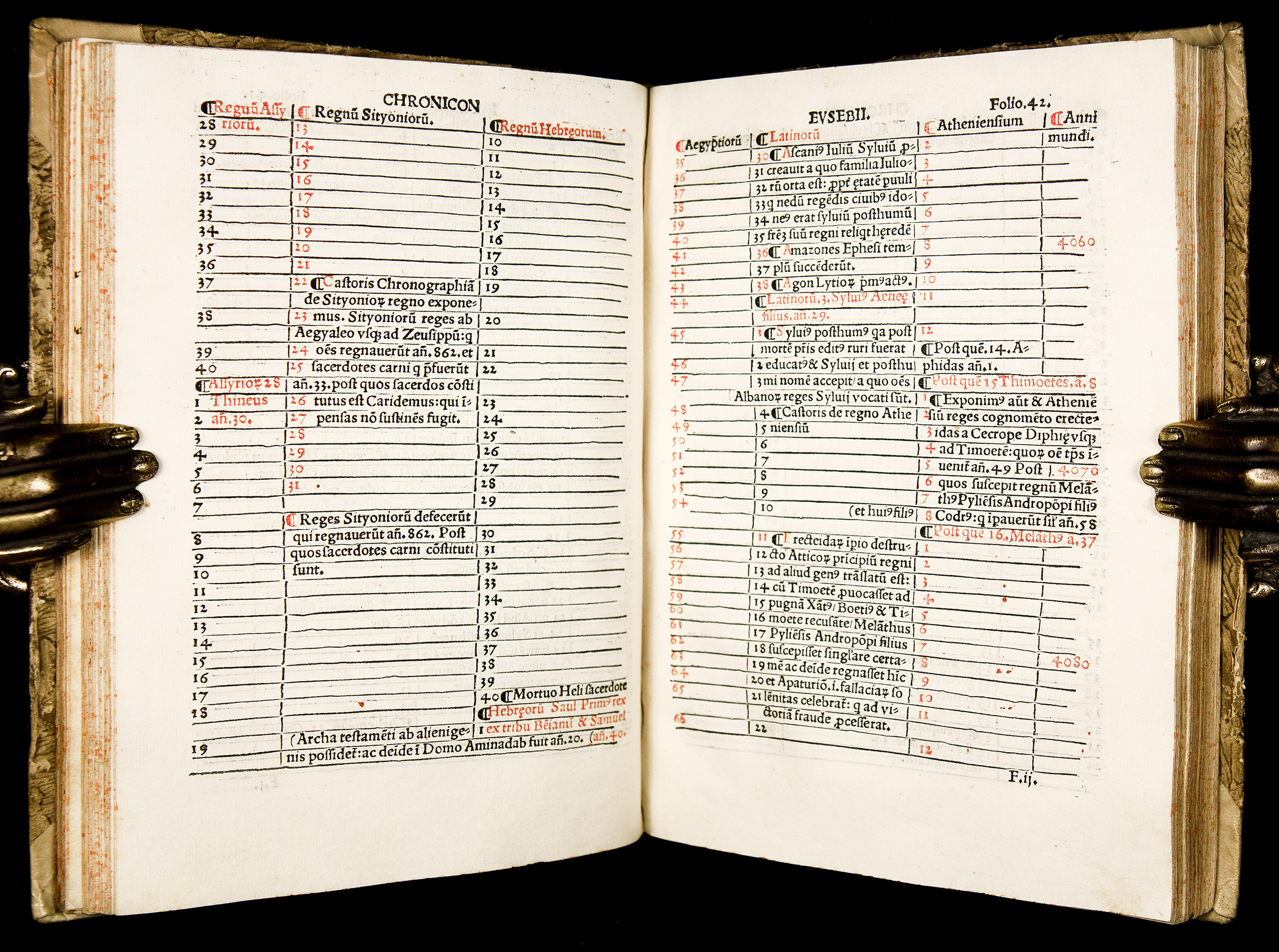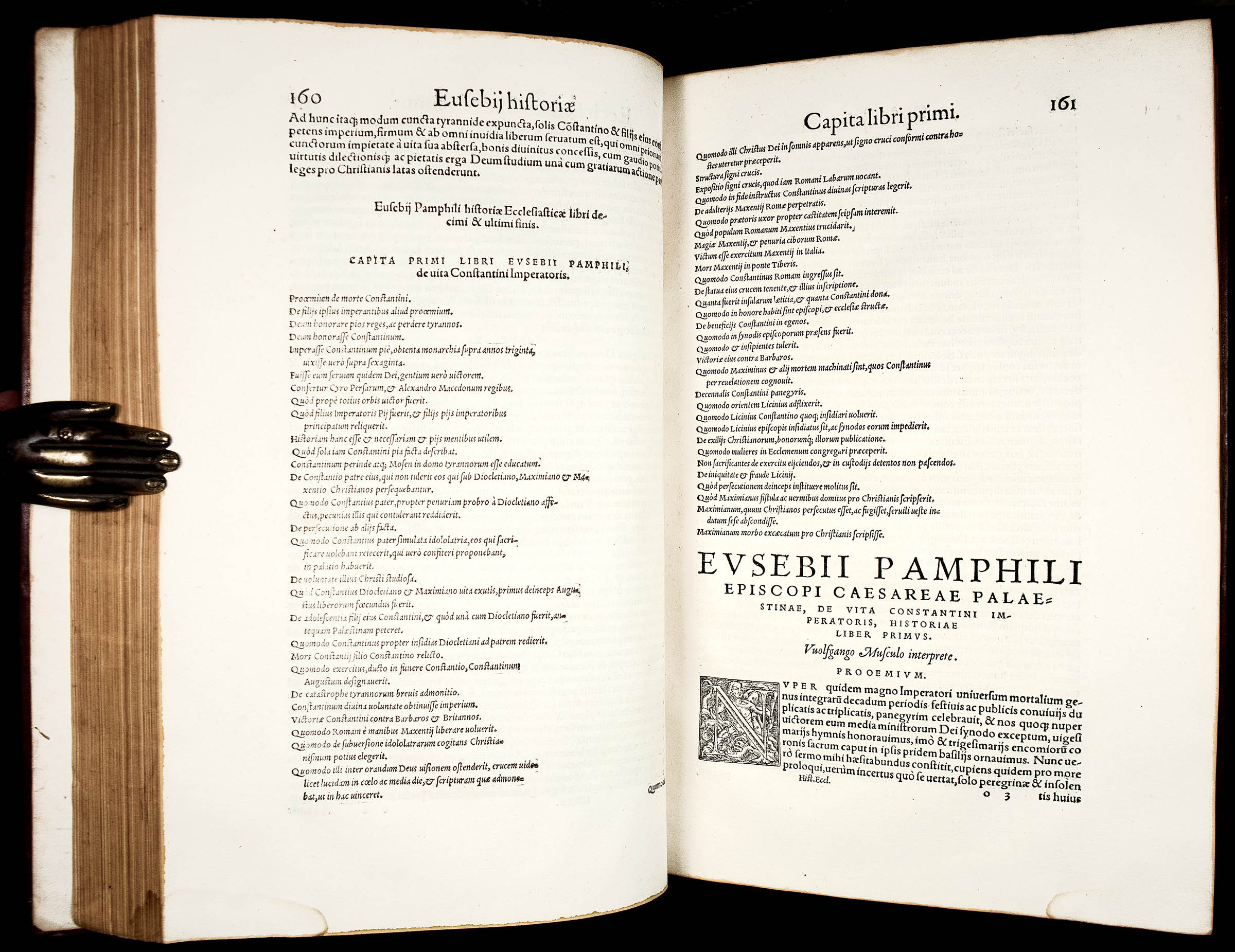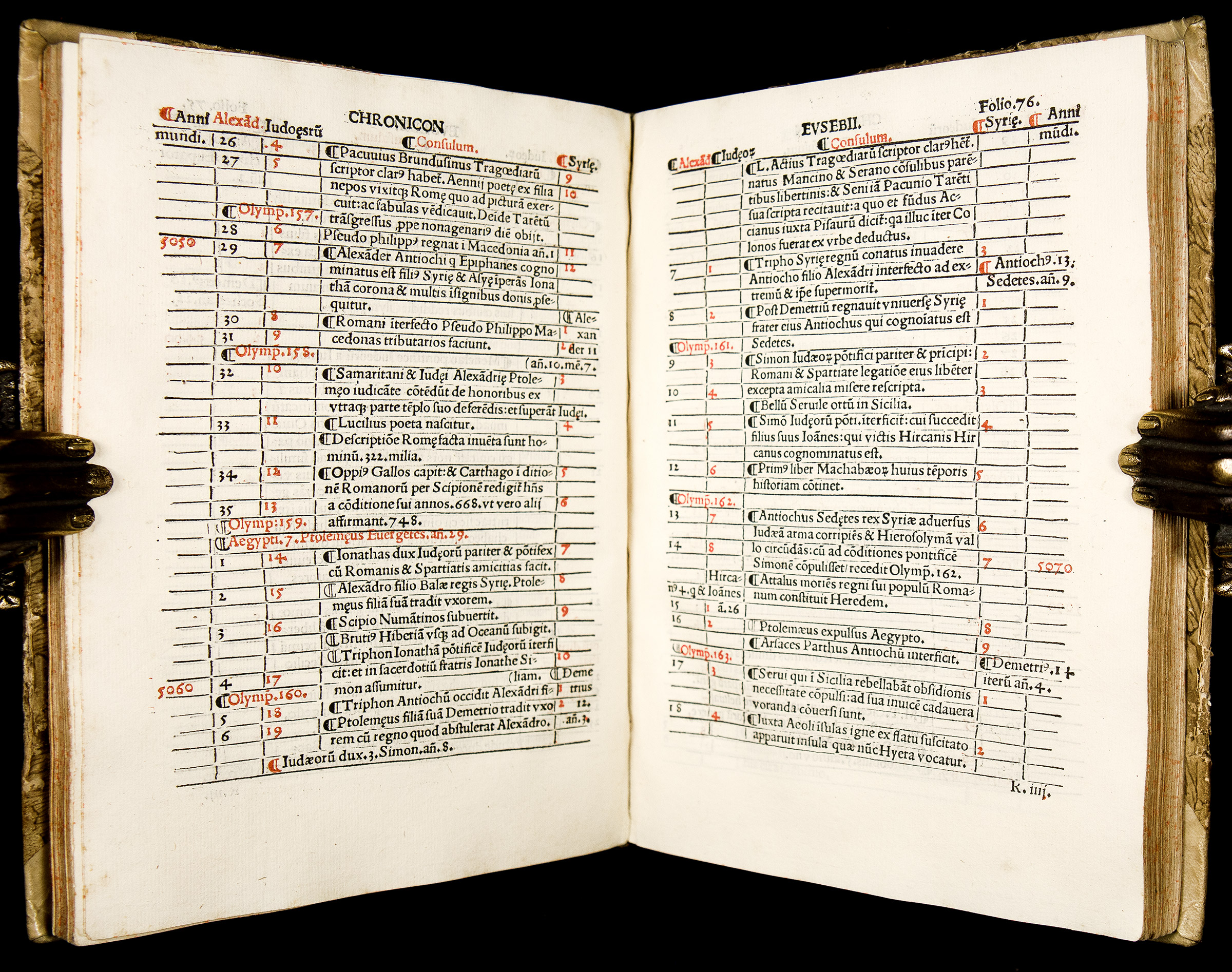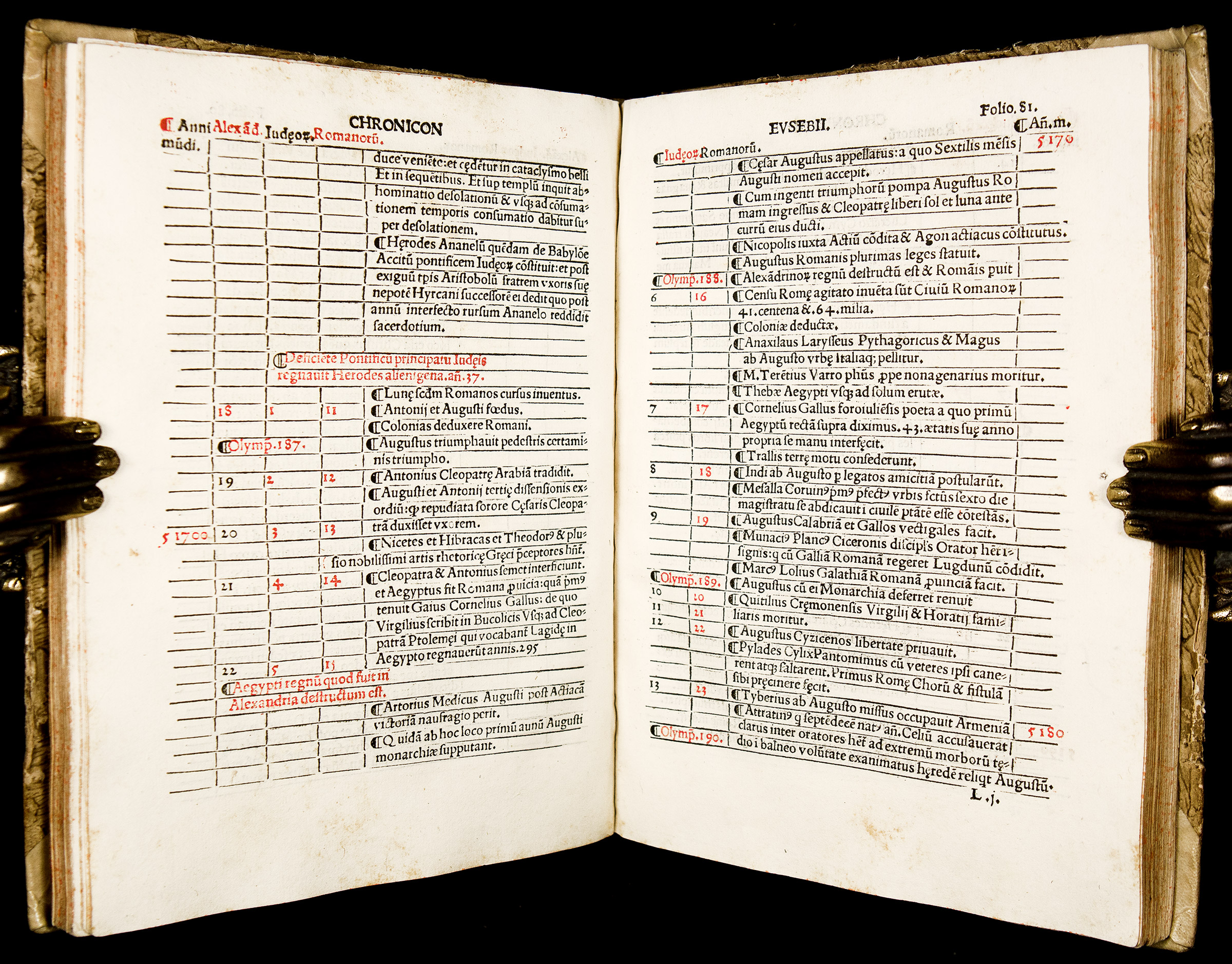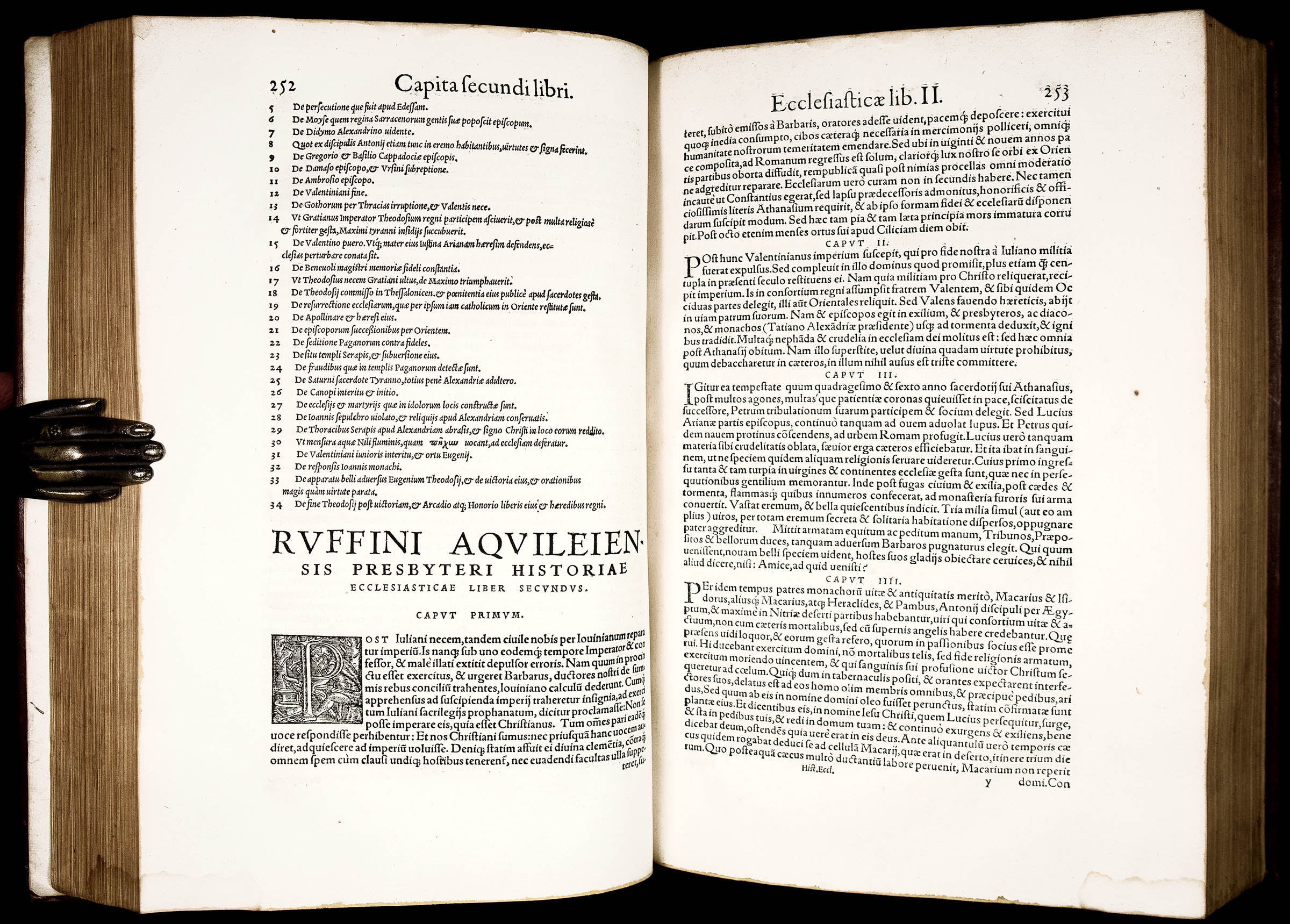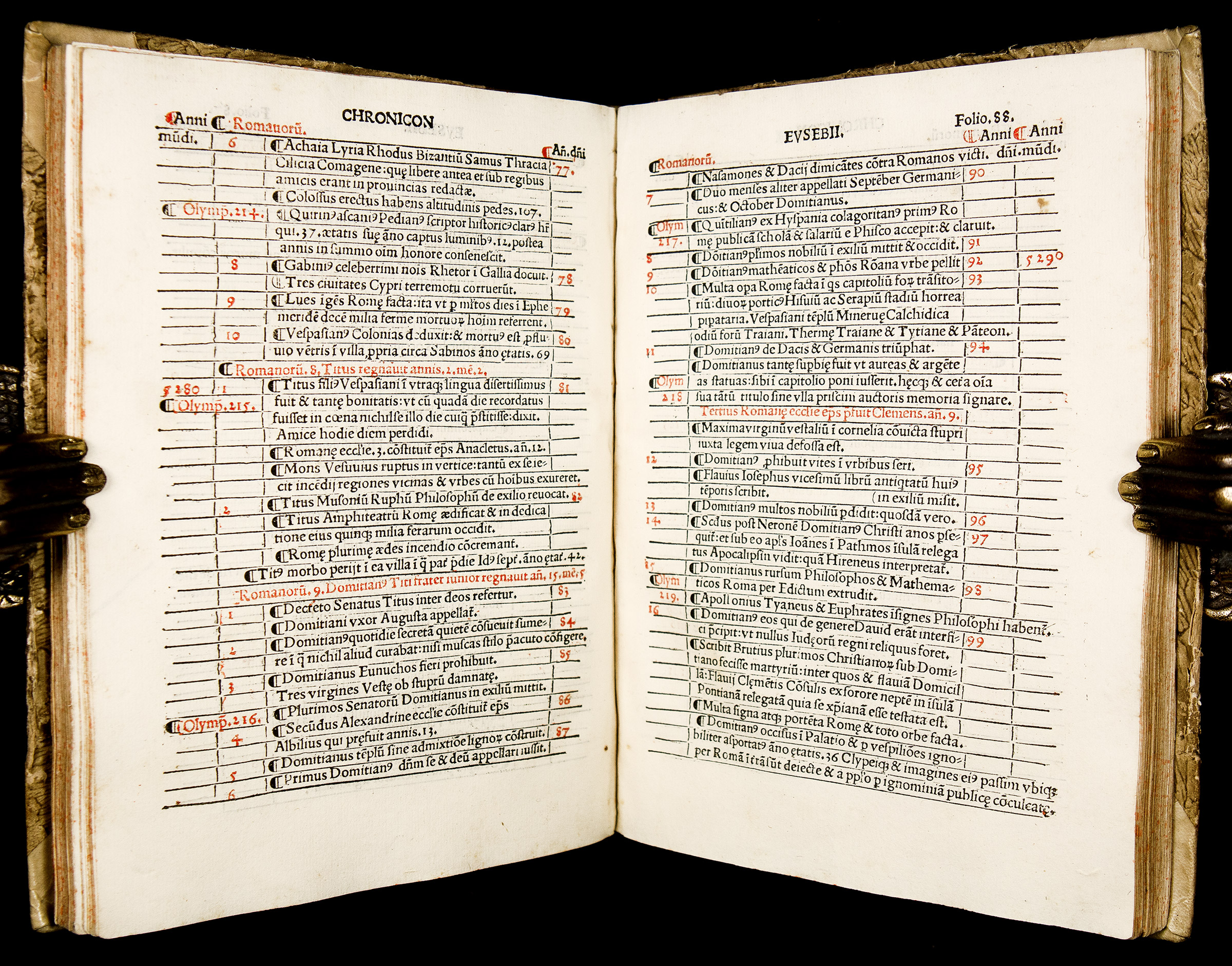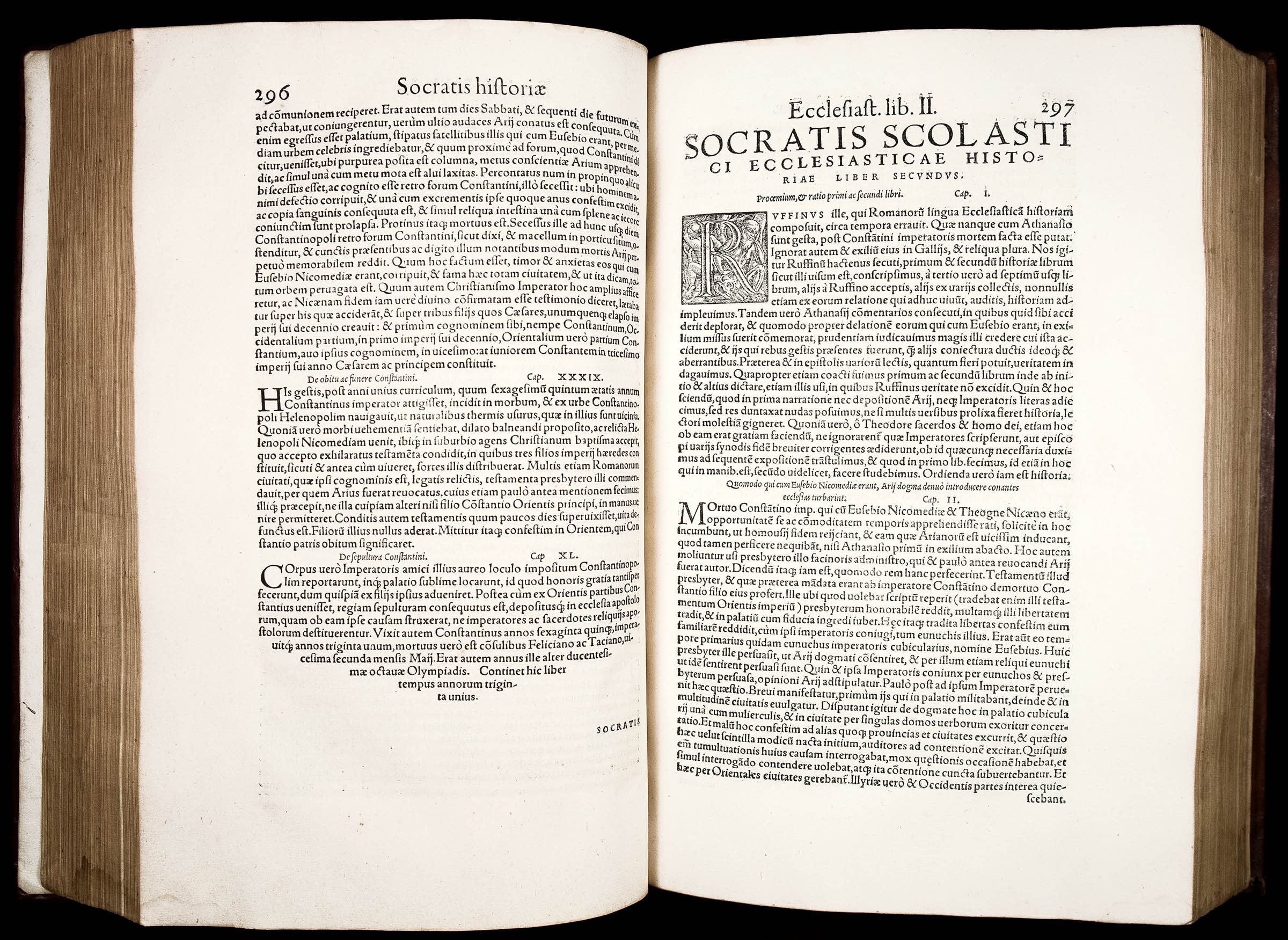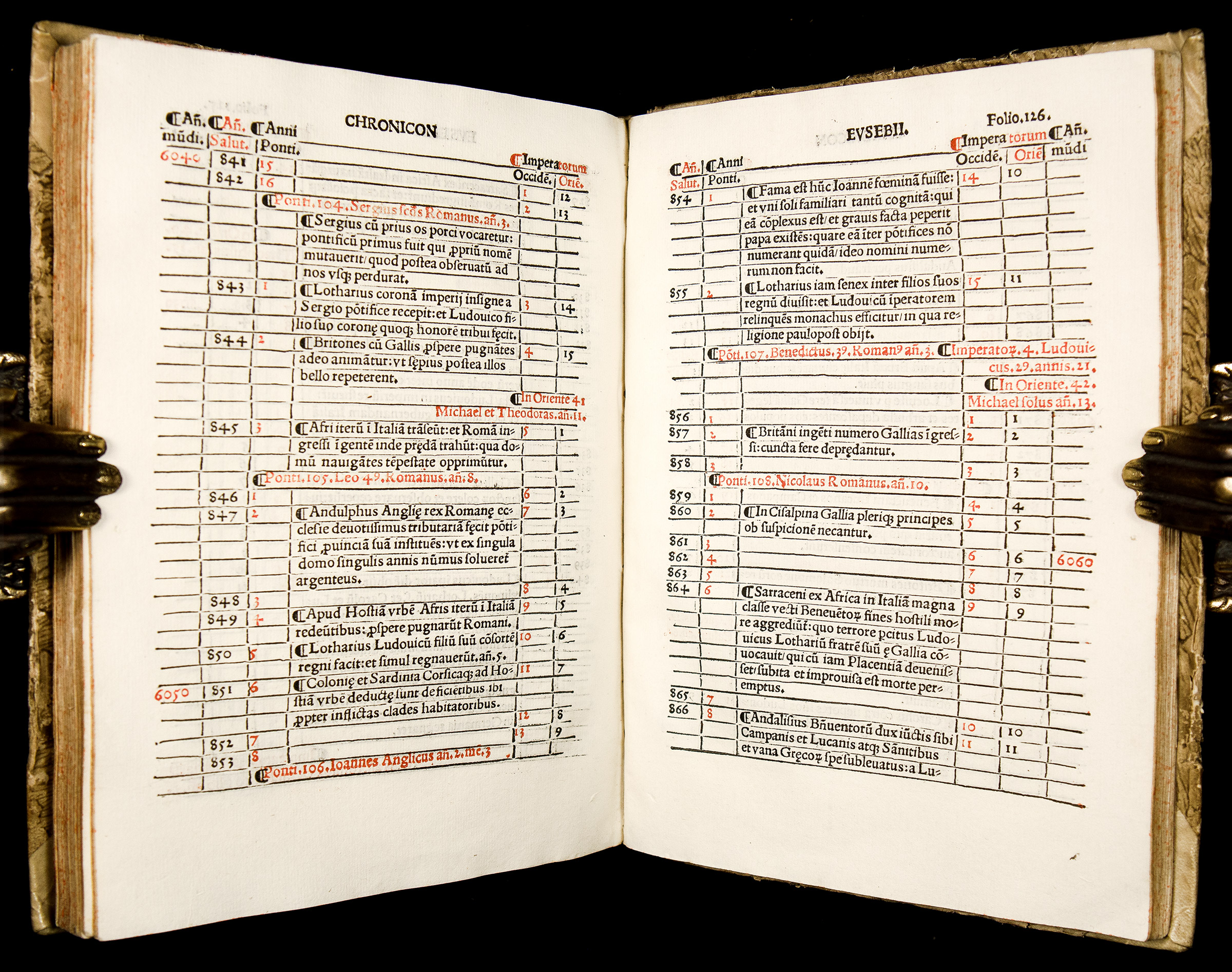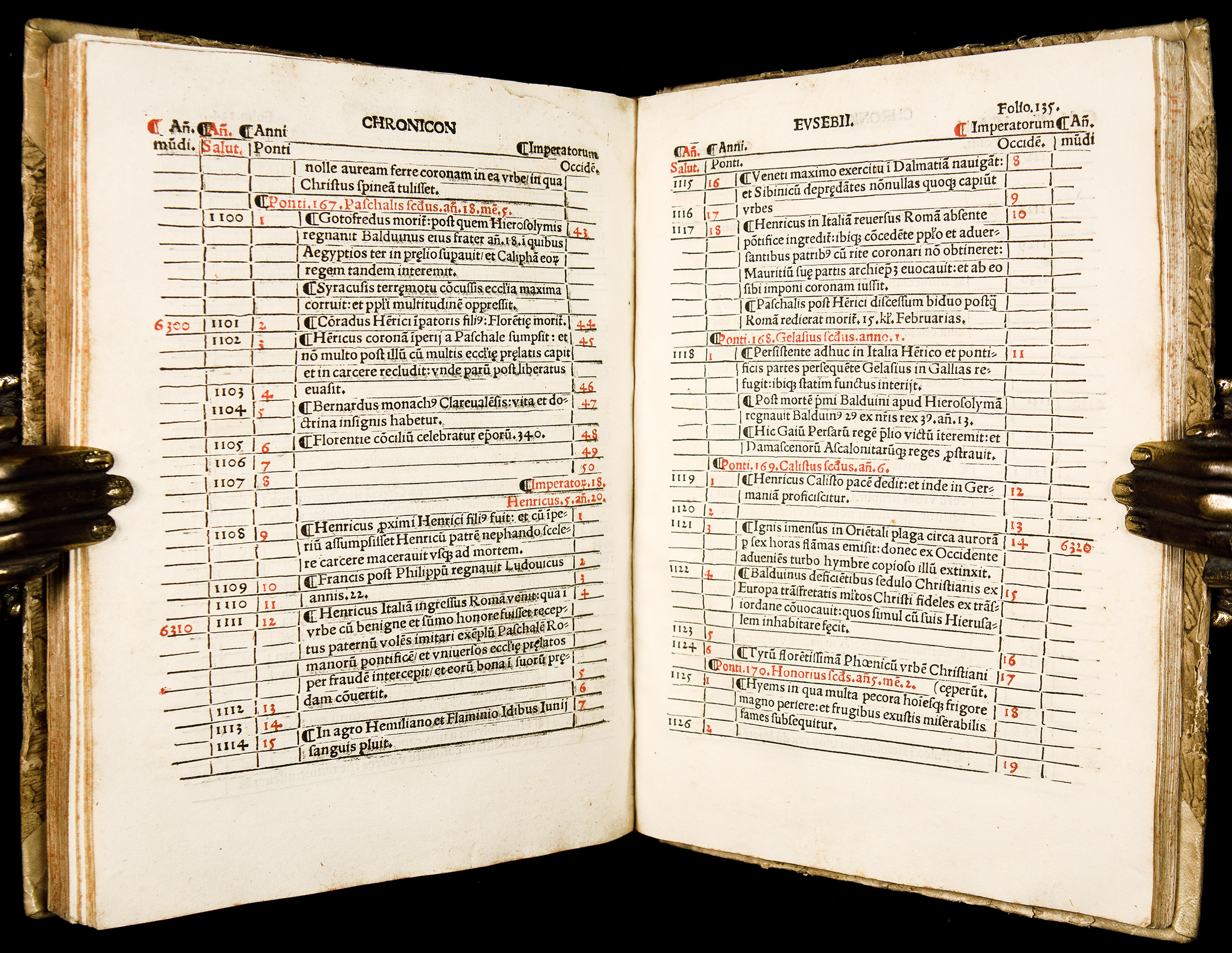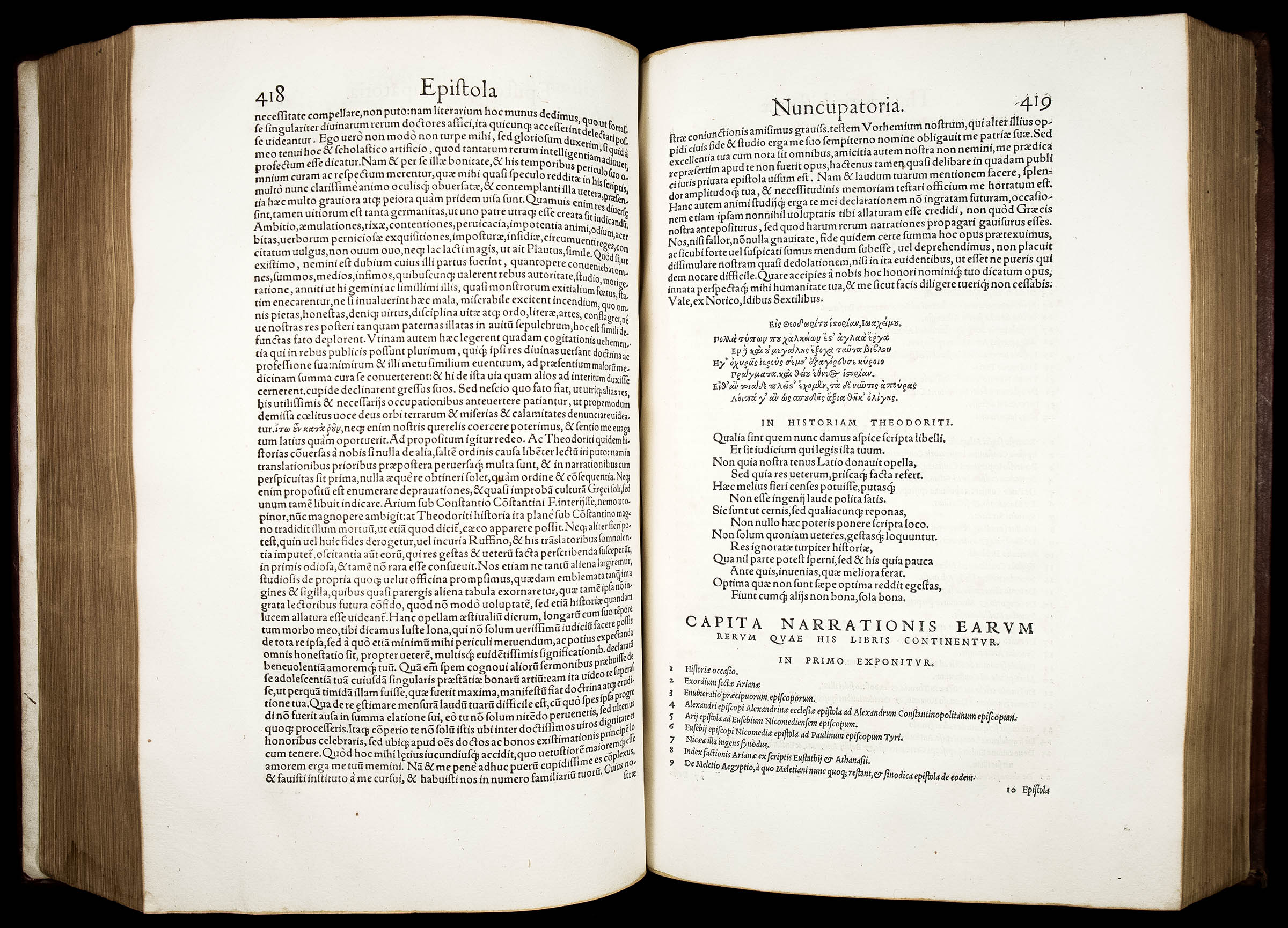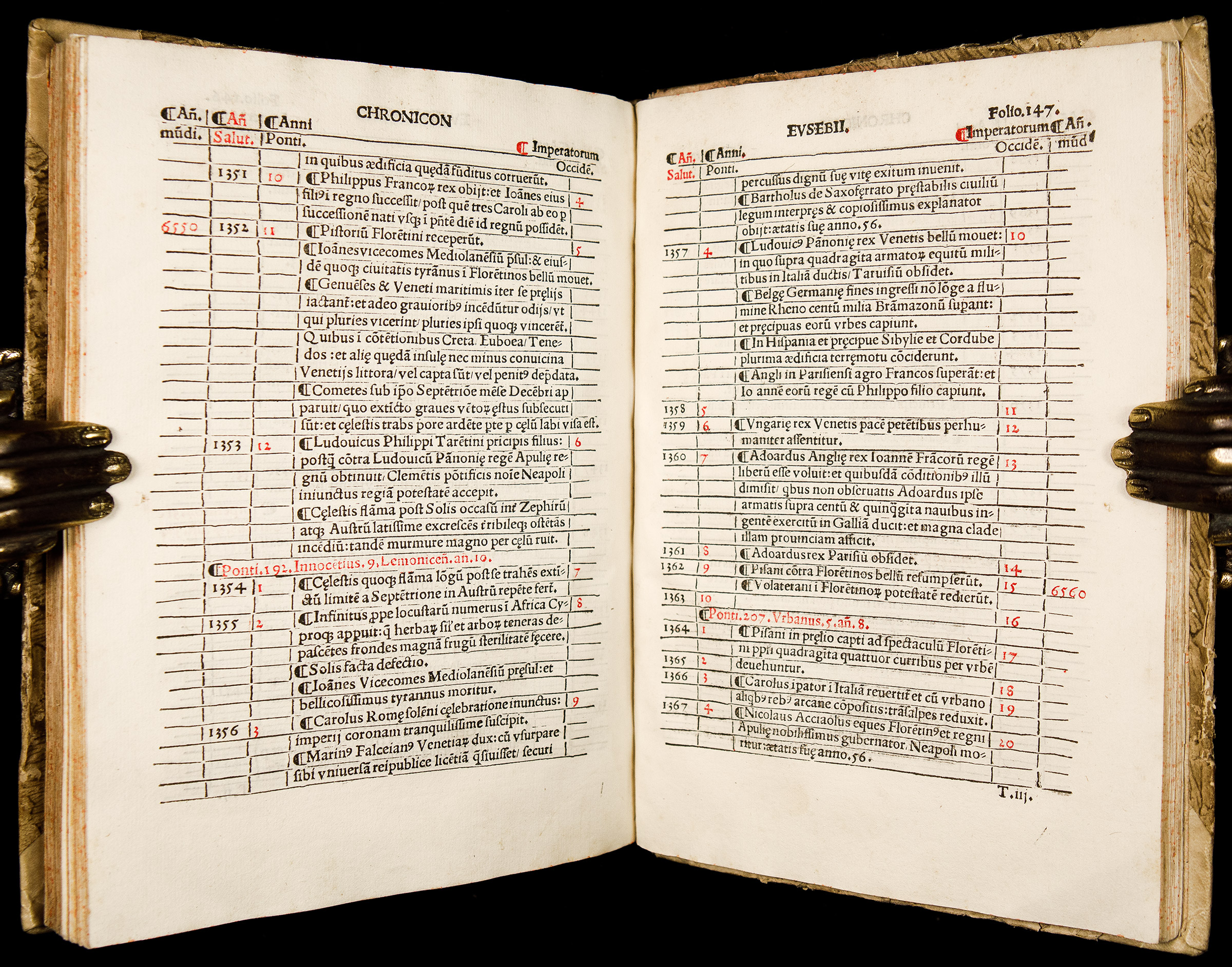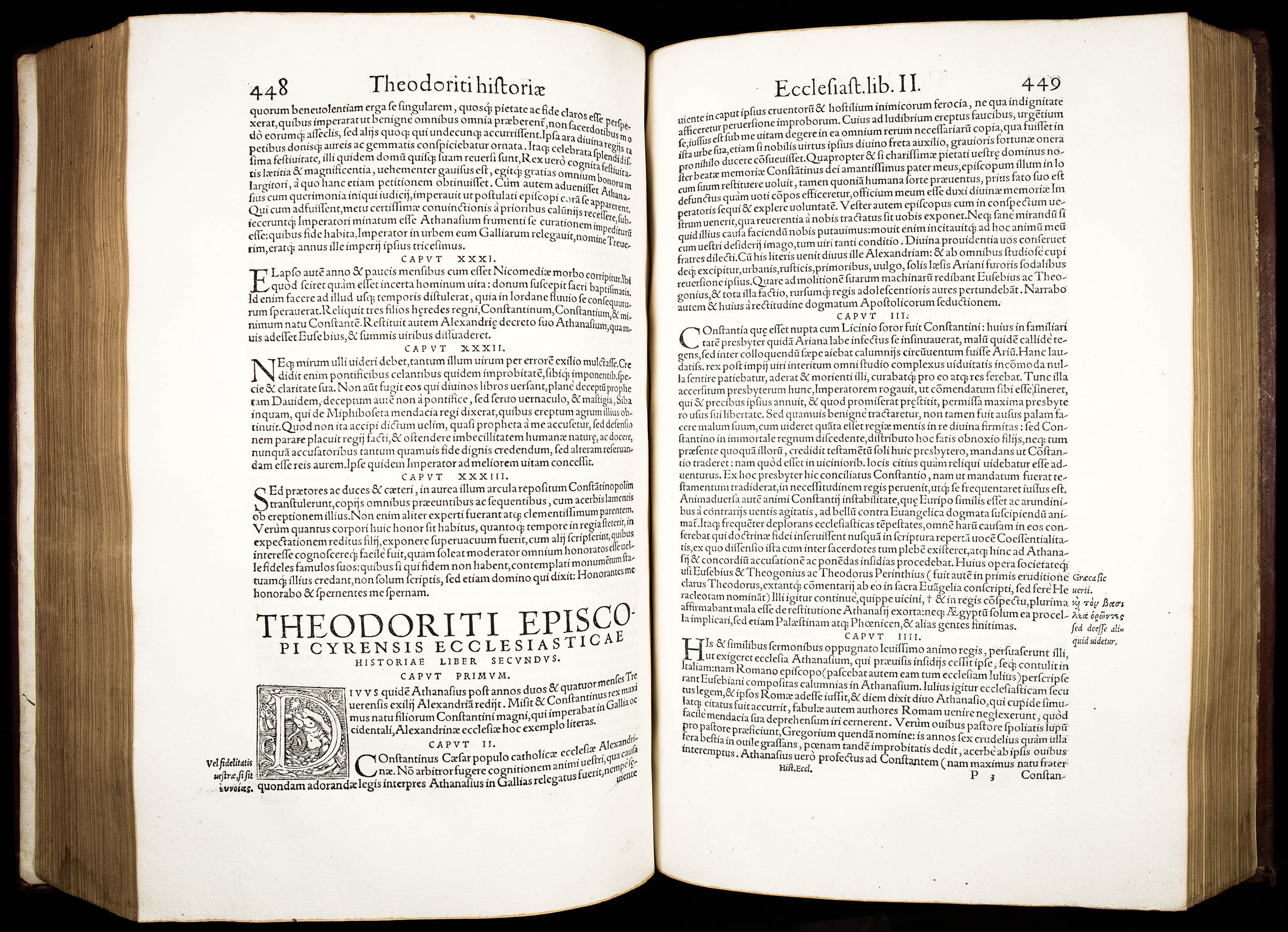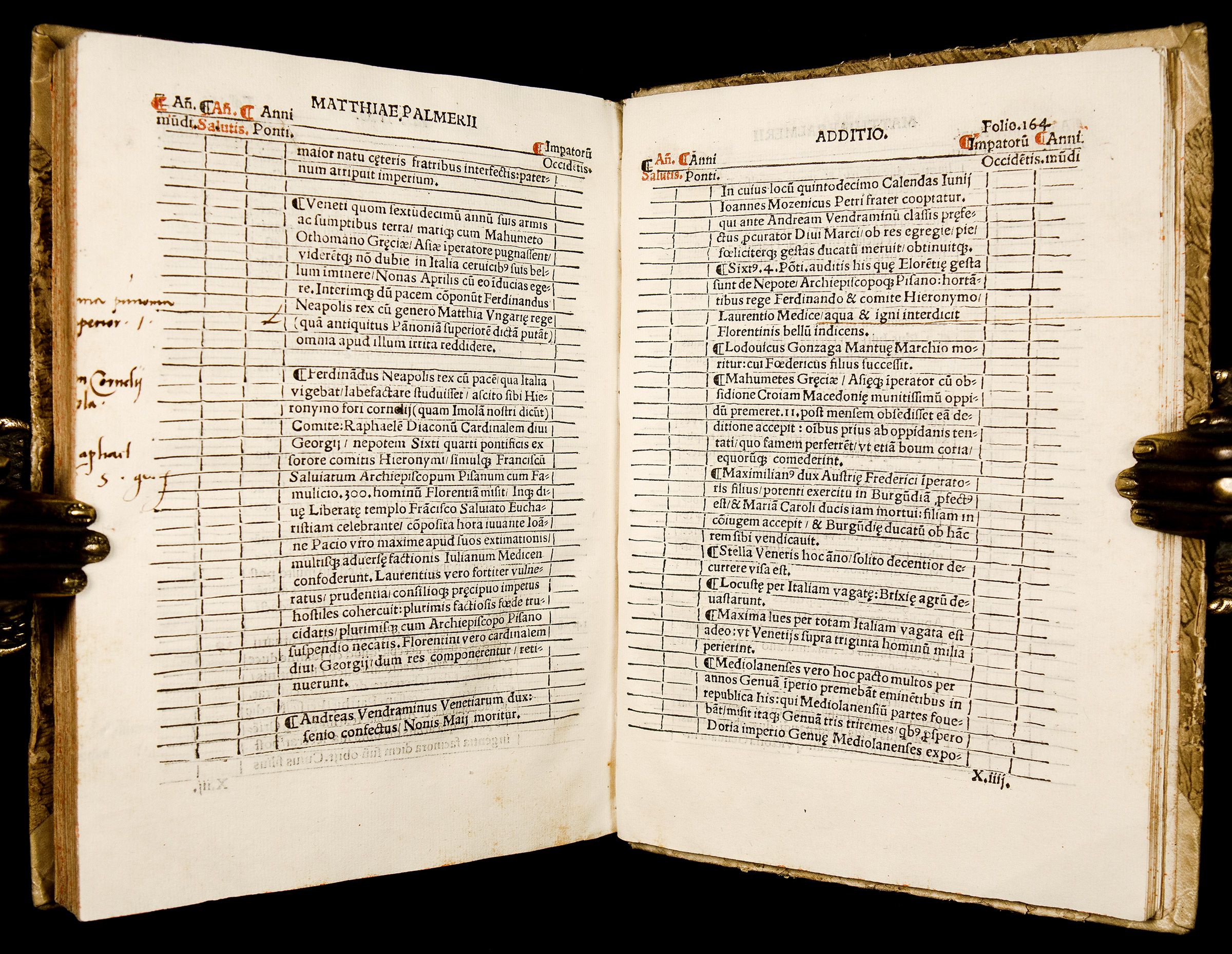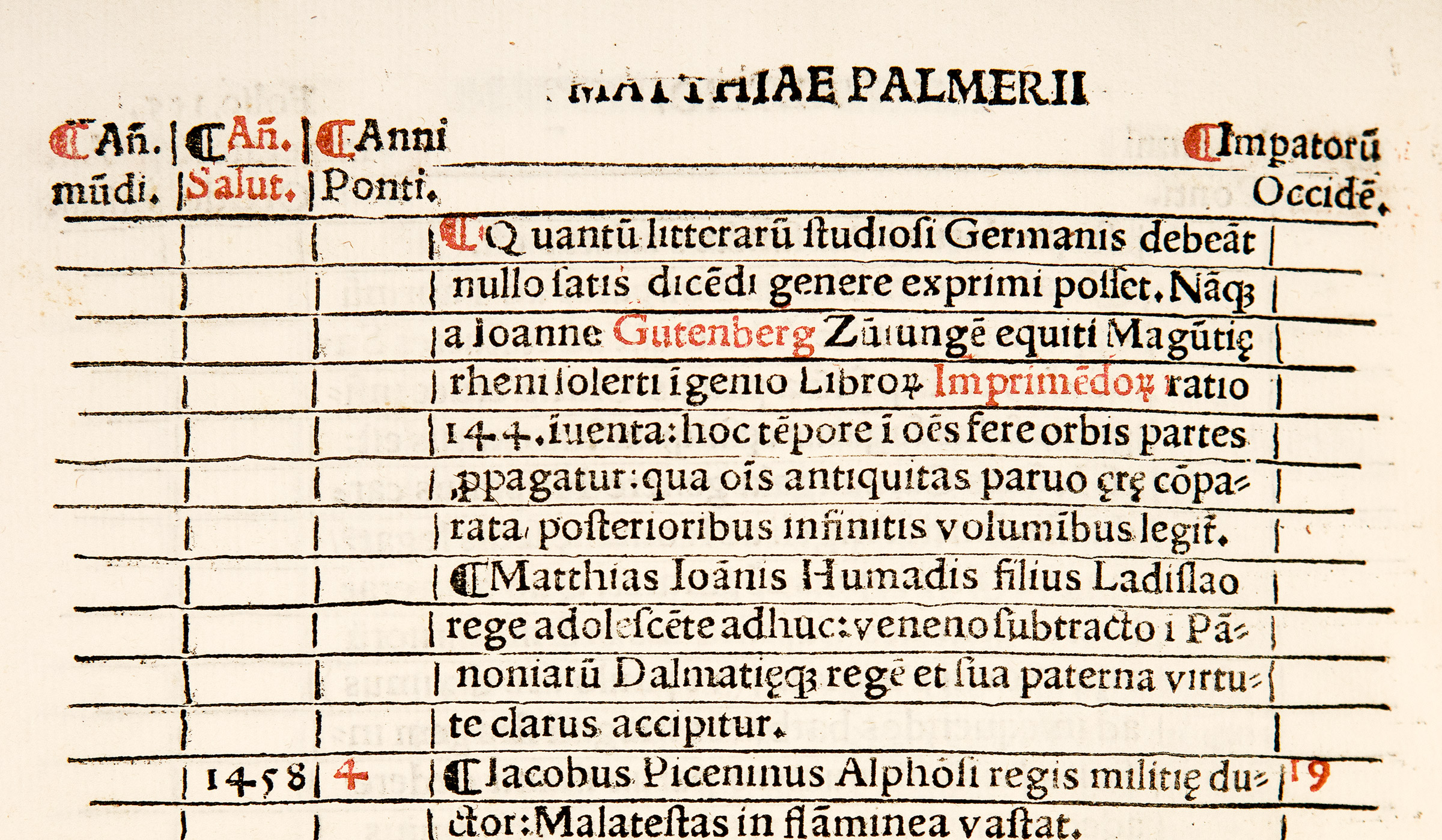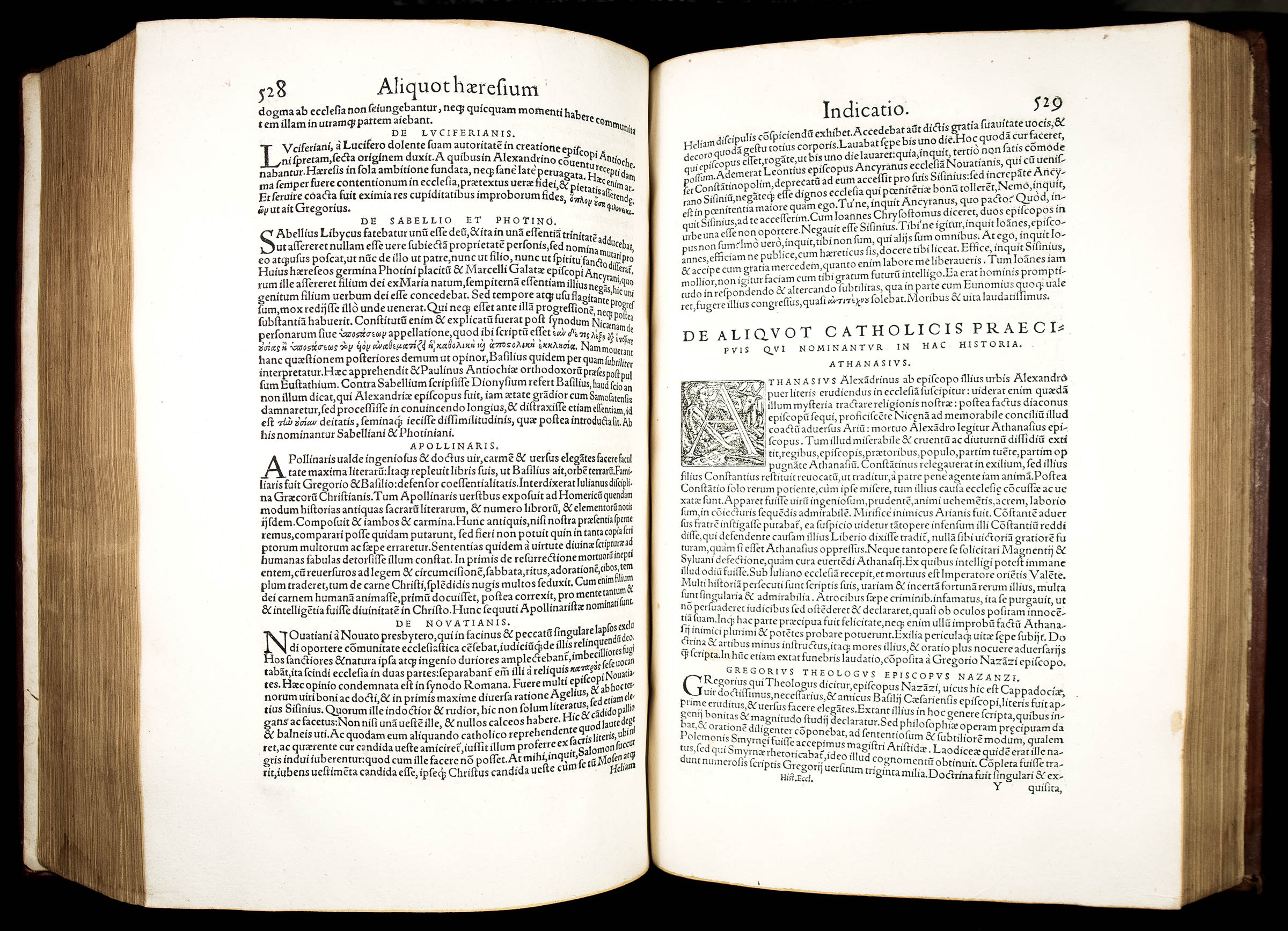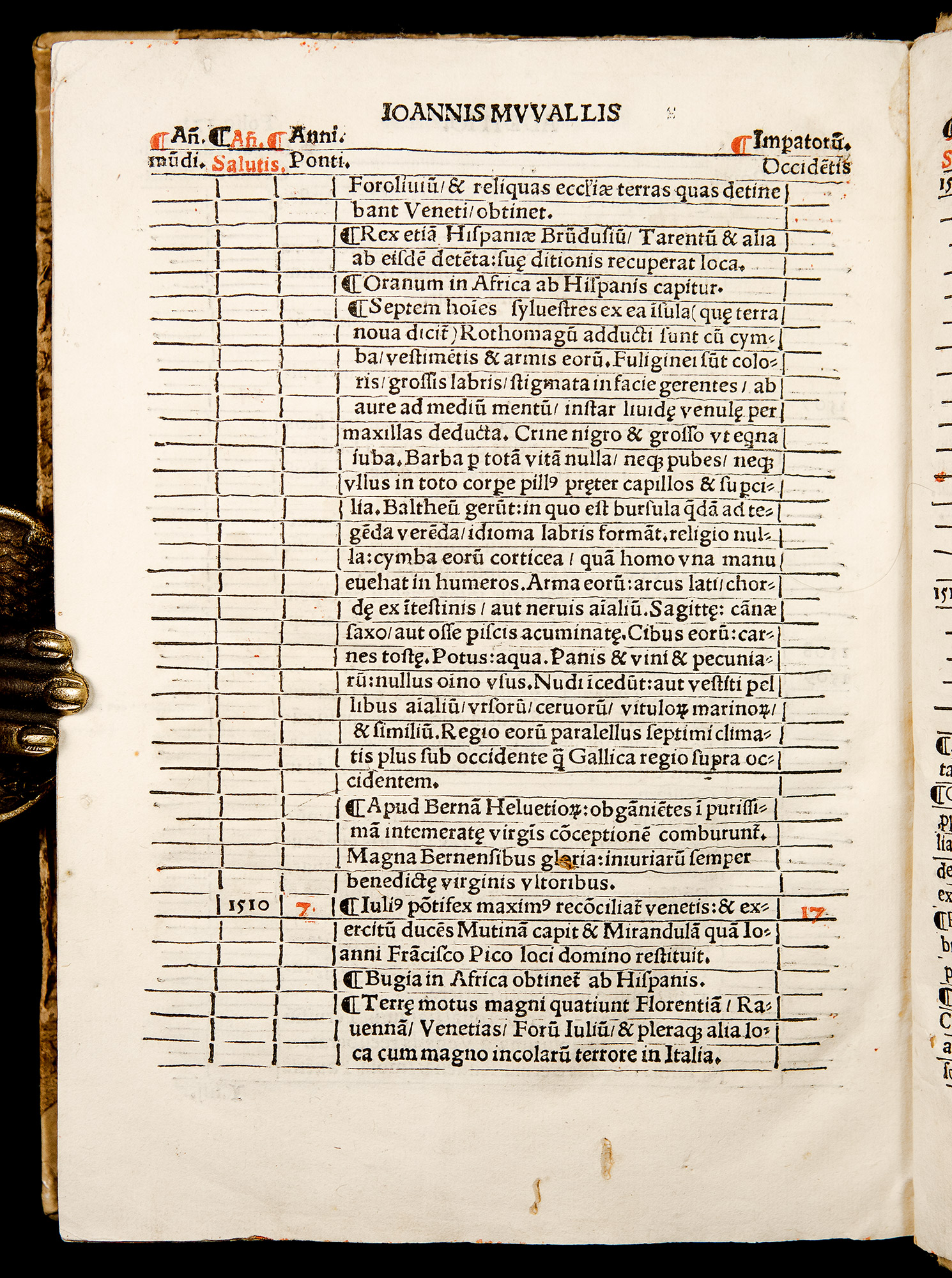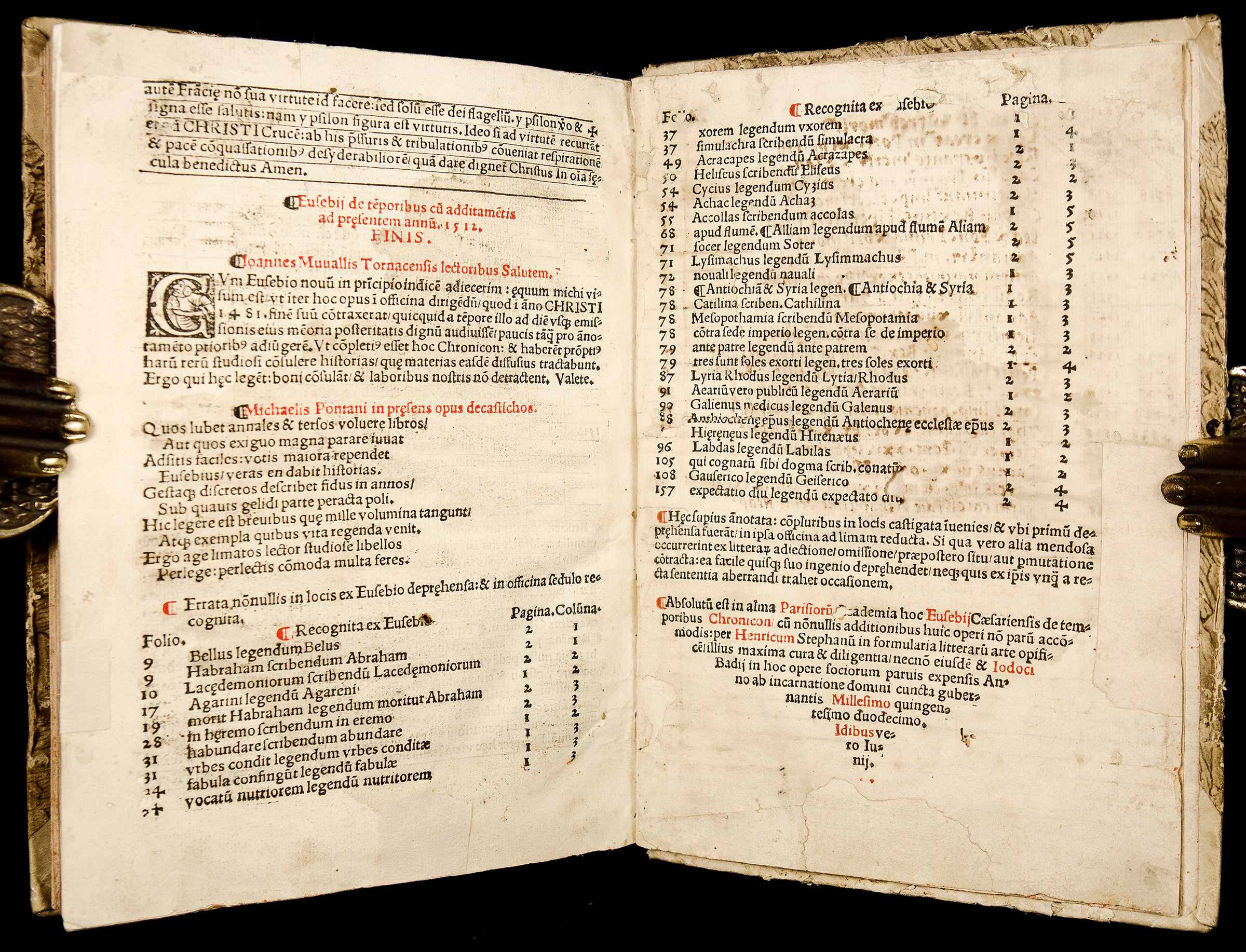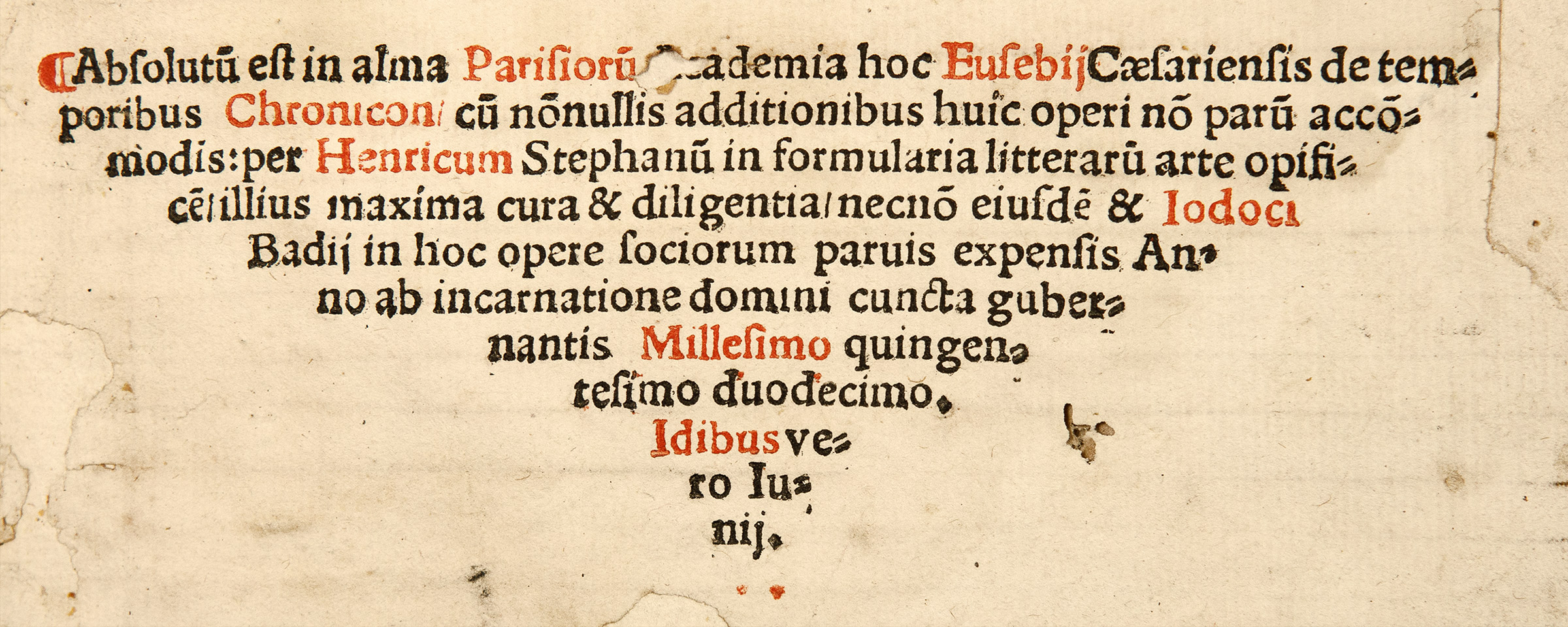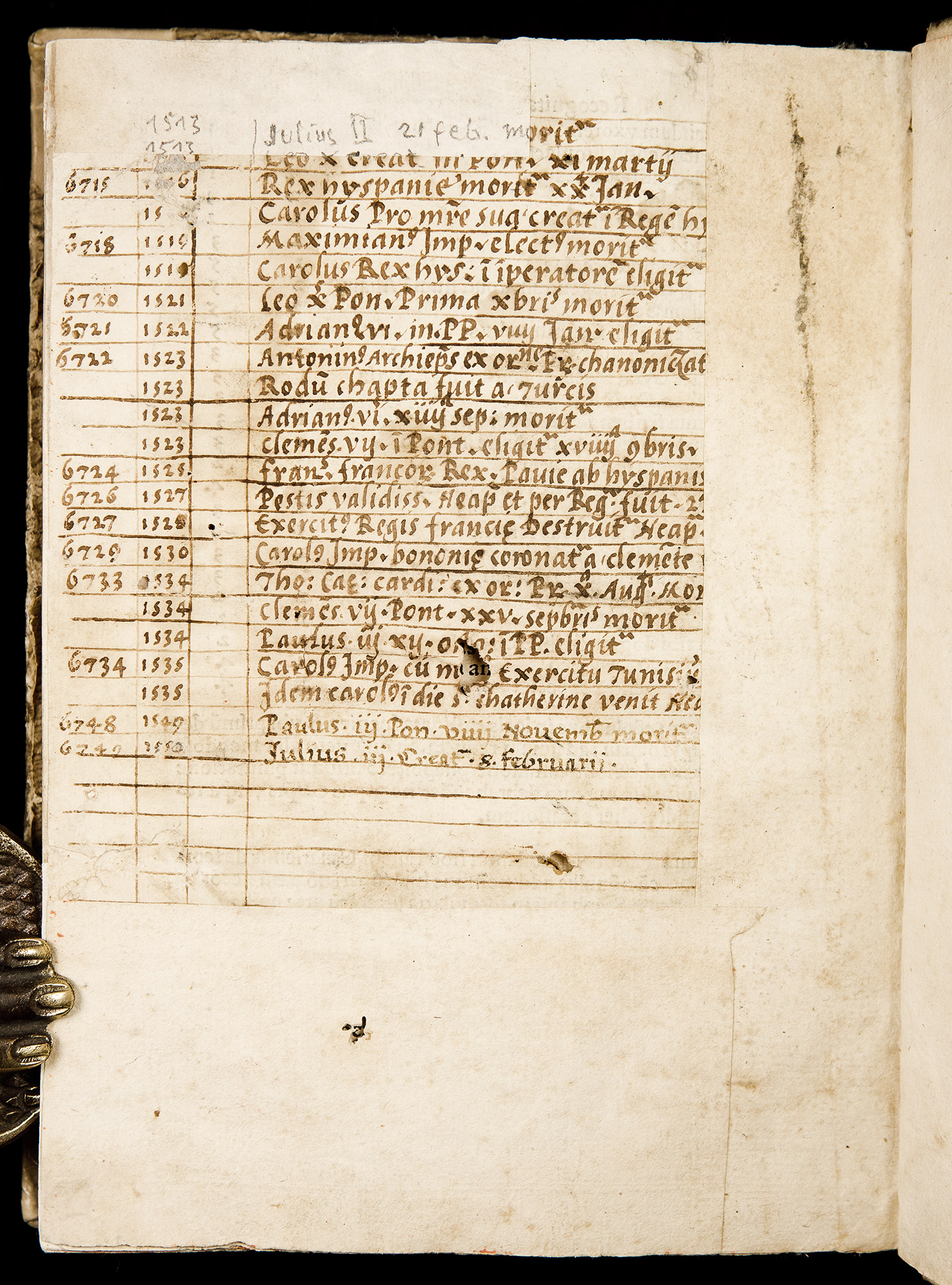
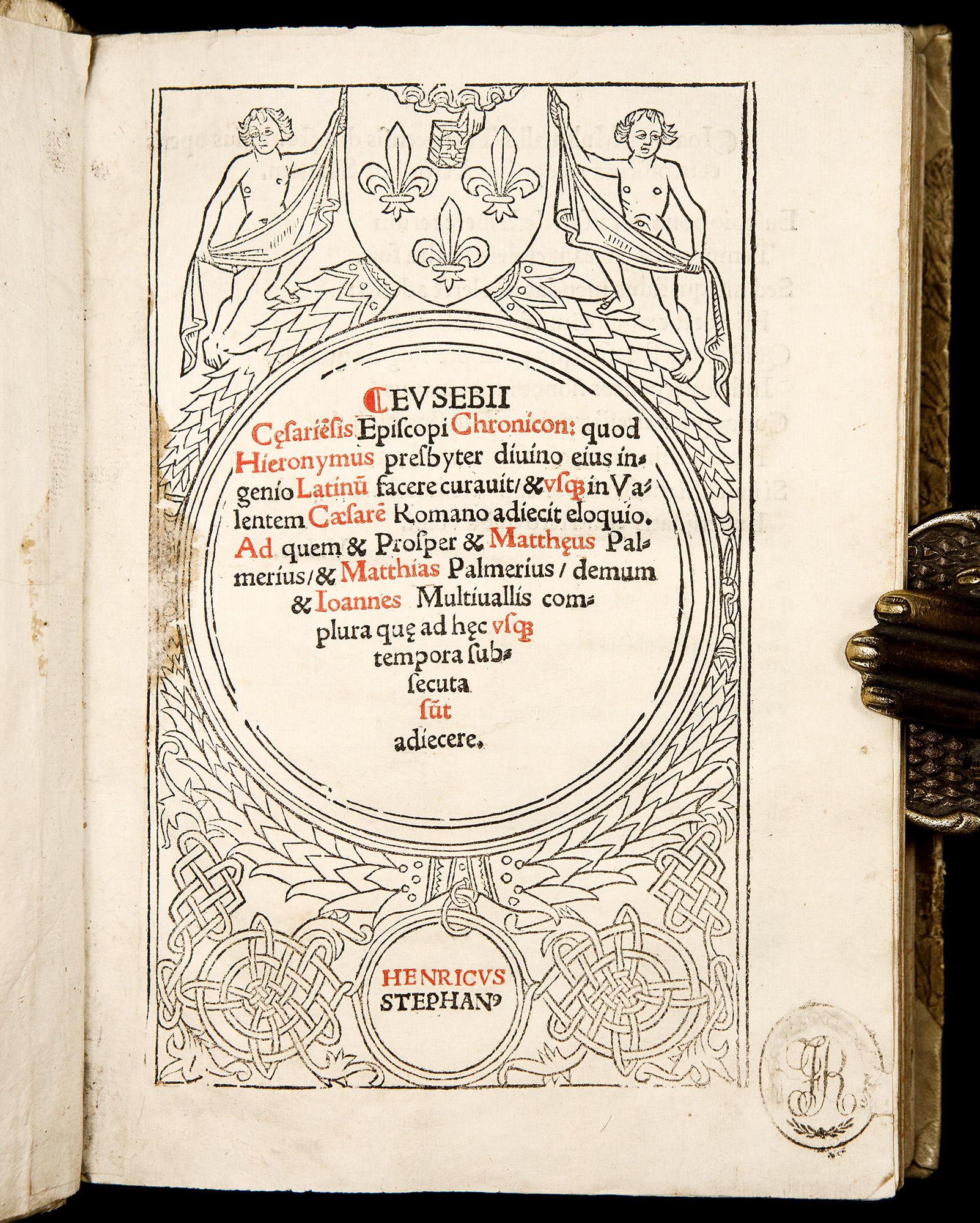
[Early Printing - post-Incunabula - Paris - Henri Estienne] [History - Ancient and Medieval - Chronicles] [Early Americana]
EUSEBIUS CAESARIENSIS
CHRONICON
Quod Hieronymus [...] Latinu[m] facere curauit, & vsq[ue] in Valentem Cæsare[m] Romano adiecit eloquio ; ad quem & Prosper & Matth[a]eus Palmerius, & Matthias Palmerius, demum & Ioannes Multiuallis complura qu[a]e ad h[a]ec usq[ue] tempora subsecuta su[n]t adiecere.
Paris: Henri Estienne (elder) for himself and Josse Bade, 1512 .
$2,400
Text in Latin. Printed in red and black throughout.
RARE FIRST ESTIENNE EDITION and the first edition edited by Jehan de Mouveaux (Johannes Multivallis) of Tournai with his additions EXTENDING THE CHRONICLE TO YEAR 1512 and including "THE FIRST ACCOUNT OF THE CANADIAN INDIAN" (Lande), as well as an important first description of the 1512 birth of the ‘Monster of Ravenna’.
This important and elegantly printed edition offers St. Jerome's Latin translation of Eusebius' Chronicon (written in Greek ca. 325 AD), continued by numerous authors up to the current events, i.e. to year 1512: “Jerome himself filled in the years 326-78; Sulpicius Severus expanded it to 403; Paulus Orosius, to 417; Prosper of Aquitaine, to 455; Idiatus, to 468; Marcellinus, courtier of the Emperor Justinian, to 534; Victor Tunnunensis or Tonnennensis, Bishop of Tunis, to 566; John of Bisclaro, to 590; etc. […] printed editions of Eusebius's Chronicon continued the tradition of offering new material. Henri Estienne's 1512 edition thus includes [Mattia Palmieri]’s update to 1481, while the period 1482-1512 is covered by Johannes Multivallis of Toumai; both additions are prominently announced on its title page.” (V. Masse in The Invention of Discovery, 1500–1700, ed. by Dr J. Dougal Fleming, p.170)
"Although the Greek original of these Tables is lost, they have survived through an ancient Armenian translation, and in the present Latin version of Jerome, who has added continuations to the year 381. The Chronological Tablesare arranged in parallel columns illustrating the whole history of the world year by year ... The [1512 Estienne’s edition] is famous for its reference to the invention of printing (under the year 1457 Mattia Palmieri records Gutenberg's invention of printing in 1440), and for several passages of American interest: e. g., under the year 1509 Multivallis has devoted considerable space to an account of the arrival of seven savages at Rouen: these are generally agreed to be American Indians - although there is some doubt whether they were from Brazil or Canada." (Schreiber)
For year 1509 Jehan de Mouveaux’s continuation includes a report of the arrival of "Septem homines sylvestres ex ea insula (quae terra nova dicit)”, i.e. seven savage men from the Islands called Newfoundland (probably Micmacs or Beothuks) brought to France by Captain Thomas Aubert. This is generally considered the first printed reference to the Canadian Indians. Mouveaux’s description gives many interesting details about these Native Americans: they have scars (tattoos) from ear to chin, their hair is black and long, they are devoid of body and facial hair, even on their chins; they have no religion; their weapons consist of a bow, the cords of which are made from intestines or sinews, and arrows; they spear fish, they eat roasted meat and drink nothing but water; their clothes are made from the skins of bears, stags, sea cows and the like; their land is at the same meridian as France.
“in 1508 or 1509, seven Americans were picked up at sea by a French vessel and taken to Rouen in France. The description of the American boat indicates that it was either manned by Newfoundlanders or by Micmacs from the Cape Breton region. Two original accounts exist describing this event, the first of which is added as an appendix by Joannes Multivallis […] to the Chronicon of Eusebius for the year of 1509. The account states […] that seven ‘sylvan’ or [forest-dwelling] men were brought from an island called terra nova to Rouen, with their boat, clothing, and weapons. They were of a darkish complexion, with thick lips, with marks [tattoos?] on their faces, extending along the jaws from the ears to the chin like livid veins. Their hair was black and thick like a horse's mane. […] Their boat was of bark and a man may raise it aloft to his shoulders, with one hand. The above account, published in 1512, has been alleged to refer to a voyage undertaken by Thomas Aubert of Dieppe in 1508.” (Jack D. Forbes, The American Discovery of Europe, p.75
Among other notable accounts included in Palmieri's continuation of Eusebius' chronological history we note a report of GUTENBERG’S INVENTION OF PRINTING IN 1440 given under year 1457. Palmieri goes on to state that printing has spread nearly over the entire globe, and that the whole of antiquity could be bought with little money, to be read by future generations in numerous volumes. Also, "under the date of 1476 there occurs a notice of the death of Monteregio [i.e. the great German astronomer and mathematician Regiomontanus], and of Ratdolt's Venetian [printing of Regiomontanus's] Kalendar" (Redgrave, p.20)
Under the year 623 AD the book documents the establishment of the "new religion" by Mohammed. The death of Mohammed is recorded under year 637. Death of Francesco Petrarca is recorded under 1374, and that of Boccaccio under 1375. Under 1348 the beginning of the "Black Death" plague pandemic is recorded, that, according to the author started "in Asia apud Indos". In the previous year (1347) the book reports the "strange vapors" moving from the North spreading terror: Ingens vapor magnitudine horribili boreali movens regionem, magno adspicientium terrore dilabitur..., as a result of which insects greatly multiplied producing a "pestilential stench". The Fall of Constantinople is recorded in the year 1453.
Numerous comet sightings (considered as omens) and monstrous births are reported. Of particular interest is an account of the ‘Monster of Ravenna’ born in early 1512 which concludes the text of Jehan de Mouveaux’s continuation (leaf Y5r,v), which, most likely, constitutes THE FIRST PRINTED ACCOUNT OF ONE OF THE MOST FAMOUS MONSTROSITIES OF THE RENAISSANCE. “According to Céard, in his edition of Des monstres…, the first account of the monster [was] written by Joannes Multivallis in a continuation of Eusebius’ Chronicon (Paris: H. Estienne, 1512). Multivallis also offers the allegorical interpretation used by Lycosthenes (Prodigiorum ac ostentorum chronicon, Basel, 1557), Boaistuau, and Bauhin.” (Kathleen P. Long, Hermaphrodites in Renaissance Europe, p.32)
The chronicler not only gives a description of the ominous creature, but offers his own moral and theological interpretation of the monster’s features, “the horn [indicates] pride; the wings, mental frivolity and inconstancy; the lack of arms, a lack of good works; the raptor's foot, rapaciousness, usury, and every sort of avarice; the eye on the knee, a mental orientation solely toward earthly things; the double sex, sodomy. And on account of these vices, Italy is shattered by the sufferings of war, which the King of France has not accomplished by his own power, but only as the scourge of God” (see Daston, & Park, Wonders and the Order of Nature, p.181-2). He also connects the monstrous birth to the current events: “In the final page of this work, Multivallis speaks of the Italian wars. He notes Julius II's preparations for war, describes the sack of Brescia and the taking of Ravenna, and concludes, precisely, with a description of the monster, which in the treatise thus becomes a worthy seal put by God to the history that humankind constructs with its own hands and by its evil deeds.” (Ottavia Niccoli, Prophecy and People in Renaissance Italy, p.50-51).
Eusebius of Caesarea (c. 263 - c. 339) became the bishop of Caesarea Palaestina ca. 314. He is often referred to as the Father of Church History. The two greatest historical works of Eusebius are his ‘Chronicle’ and his ‘Ecclesiastical History’. The "Chronicon", or "Chronicle" (Greek, "Pantodape historia", "Universal History"), was compiled in the early 4th century and contained a world chronicle from Abraham until the vicennalia of Constantine I in 325 AD. The work consisted of two parts (or books). Book 1 contained sets of extracts from earlier writers; book 2 contained a technically innovative list of dates and events in tabular format. The original Greek text is lost, although substantial quotations exist in later chronographers. Both books are mostly preserved in an Armenian translation. Book 2 is entirely preserved in the Latin translation by Jerome. Portions also exist in quotation in later Syriac writers such as the fragments by James of Edessa and, following him, Michael the Syrian.
The work was divided into two parts. The first part (Greek, "Chronographia", "Annals") gives a summary of universal history from the sources, arranged according to nations. The second part (Greek, "Chronikoi kanones", "Chronological Canons") furnishes a synchronism of the historical material in parallel columns, the equivalent of a parallel timeline, where each line is a year.
"The ‘Chronography’ is an epitome of universal history. It is divided into five parts:
(1) the history of the Chaldeans, and the Assyrians, followed by lists of the Assyrian, Median, Lydian, and Persian kings;
(2) Old Testament history;
(3) Egyptian history;
(4) Grecian history;
(5) Roman history.
Like the "Praeparatio Evangelica", it is full of quotations from lost authors. [The existing accounts of the] Babylonian story of the Creation and the Flood owe their preservation to Eusebius. The ‘Canons’ are a series of chronological tables with short historical notices. The years of Abraham, beginning from the supposed date of his birth, form the backbone. Alongside of these are placed the regnal years of the monarchs of different kingdoms as they rose and fell." (Catholic Encyclopedia)
Eusebius' Chronicon with its revolutionary tabular format in St. Jerome's Latin translation (dating from ca. 380) gained a considerable influence and became the primary available source of information on dates and events from the time of its composition until the end of the middle ages.
Physical description:
Quarto, text block measures 206 mm x 150 mm. Bound in 17th-century (?) quarter-vellum over marbled boards with vellum corners (vellum appears to have been reused from a contemporary document, with faint traces of ink writing). Edges speckled red.
Title within woodcut border, woodcut initials printed in red-and-black.
Foliation: [20], 175 [i.e.173], [1] leaves (forming 388 pages).
Signatures: a-b8 c4 A-X8 Y6.
Collated and COMPLETE.
Title within woodcut border, within a fine woodcut border, with winding vines and other ornamentation, and incorporating the arms of the University of Paris (top) and the printer’s name ‘Henricus Stephan[us]’ (bottom).
Text printed in roman letter, in red-and-black (except for the preliminaries) with headlines and dates in the chronological tables printed in red. Numerous woodcut and metal-cut decorative initials in various styles (including a large 12-line ’T’ on a2r and a large 9-line ‘A’ on A1r, both in ‘white vine’ style). Pages of the chronological tables ruled horizontally and vertically.
Preliminaries include a short address to the reader in five distichs by the editor Jehan de Mouveaux (a1v), and an extensive Index (a2r-c4v). Also included at the end of the volume are Mouveaux’s short concluding epistle to the reader (Y5v), followed by a poem (decastichon) by Michael Pontanus, and Errata (Y5v-6r).
Colophon on Y6r (verso blank).
Bibliographic references:
Adams E-1073; Renouard Estienne, p. 12-13, no 15; Harrisse 71; Sabin 23114; Alden-Landis 512/5; Lande S733; Streeter I:91; Bibl. Americana: J. Carter Brown Library. p.53-4.
Provenance:
A late 19th- or early 20th-century armorial bookplate (on front pastedown) ‘Ex-libris M. Lugol’.
Bookplate (on front free endpaper) of Bernd Oetter (born 1937), a German lawyer and diplomat, who was Ambassador of the Federal Republic of Germany to Papua New Guinea, the Solomon Islands and Vanuatu, and from 1998 to 2002 he was the German Embassador to the Holy See in Rome.
Bottom outer corner of title-page with an old collector’s stamp with a monogram ’F.R.’
Several manuscript marginal notes in a 16th-century humanist hand.
A 16th-century owner’s manuscript notes to blank verso of the final leaf, extending the Chronicle with some current events up to 1550 wi
Condition:
Very Good antiquarian condition. Complete. Binding rubbed with wear to edges. Two former owners’ bookplates to Text-block somewhat ‘over-opened’ around the middle, but binding still solid. Title-page with a small stain to the left side of the woodcut border; inner margin neatly reinforced; old collector’s stamp to bottom corner of outer margin. Internally with occasional light soiling or spotting; several pages with manuscript marginalia (partially faded and/or cropped during binding). Final leaf with some marginal repairs and two small holes (but no loss of legibility), and with some manuscript notes to its blank listing several events of the 1513-1550 period, as an ‘extension’ of the chronicle. In all a nice, genuine, well-margined example of this important, rare, elegantly printed edition.
